Ohio Reptiles and Amphibians, 2017
Here are some reptiles, amphibians, and a few other things that I observed
in southeastern Ohio in 2017, in mostly chronological order.
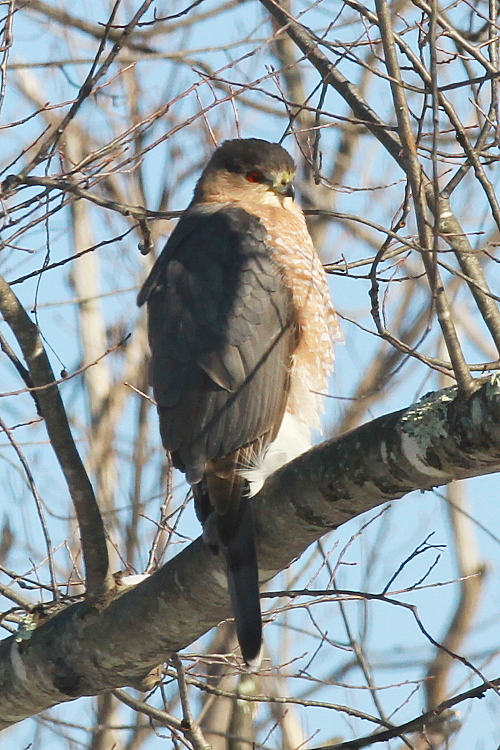
A Cooper's Hawk (Accipiter cooperii) photographed through our
kitchen window on January 7.
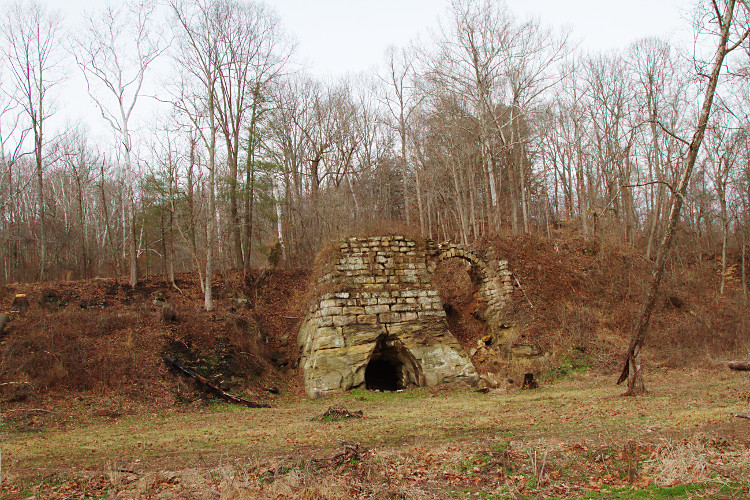
The Olive Furnace in Lawrence County, Ohio. It was built in 1846 and produced
iron until 1910. Over the past year or so, the landowner has cleared the
brush and trees around it so that it is easy to see from the road.
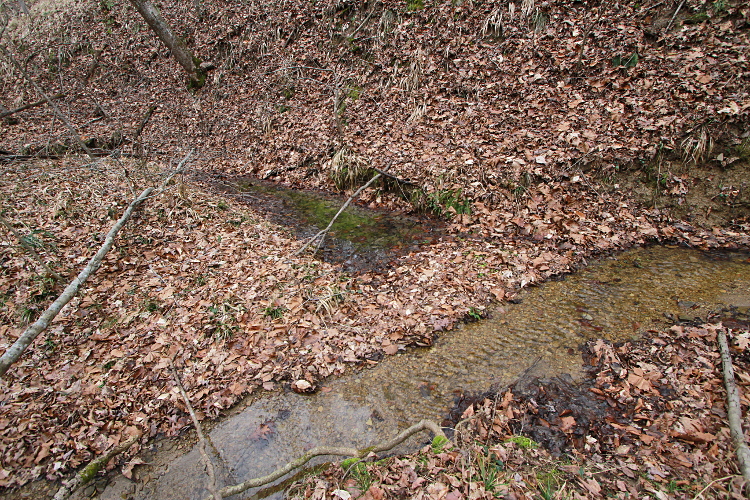
This seepage-fed pool next to a small stream caught my attention.
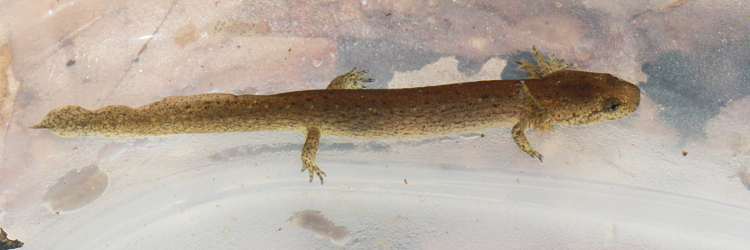
As I had hoped and expected, dipnetting the pool produced a
Mud Salamander larvae (Pseudotriton montanus).
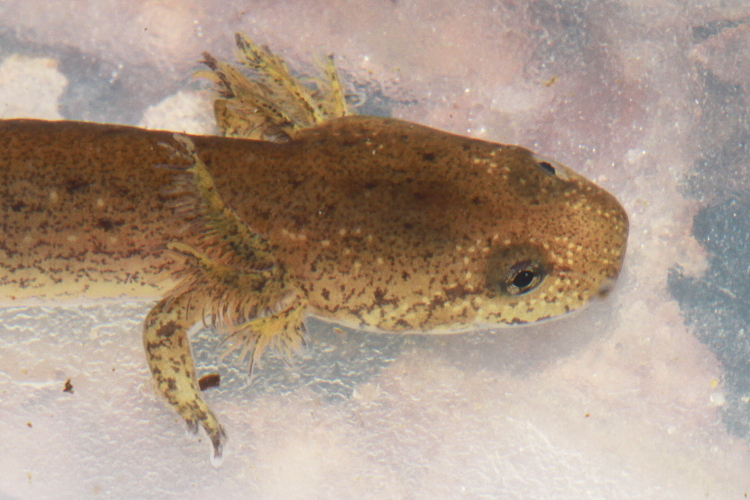
A closer look at the larva.
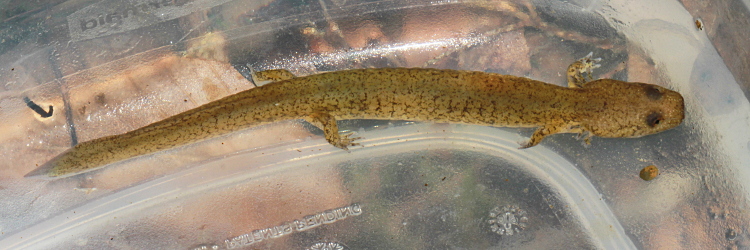
A Northern Spring Salamander (Gyrinophilus porphyriticus porphyriticus)
larva found elsewhere in Ohio.
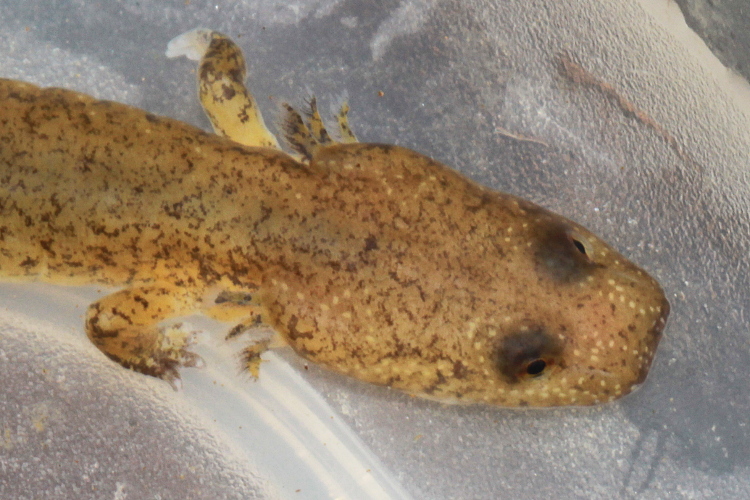
A closer look.
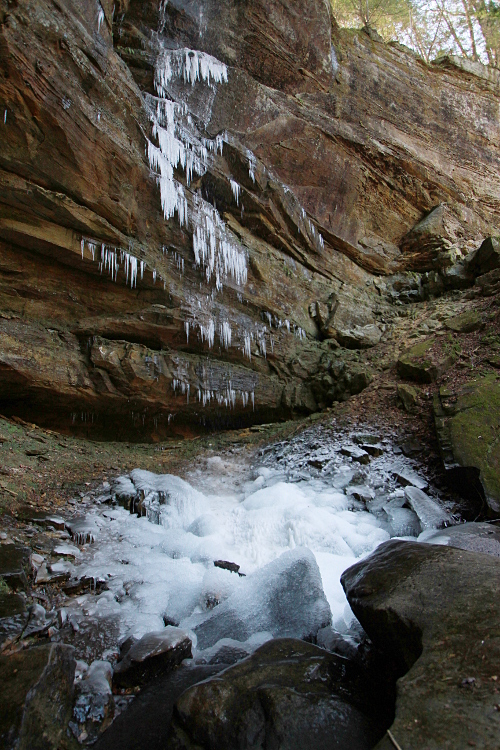
Some ice in early February.
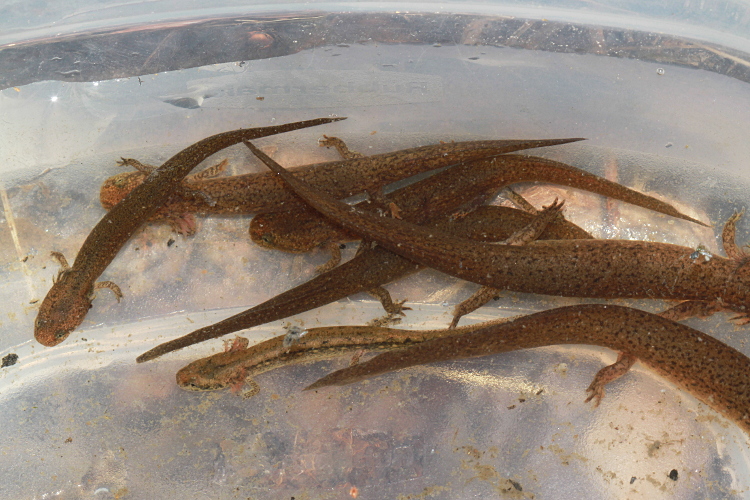
A bunch of Red Salamander (Pseudotriton ruber) larvae
found in February. There is also one Southern Two-lined Salamander
(Eurycea cirrigera) larva in the foreground.
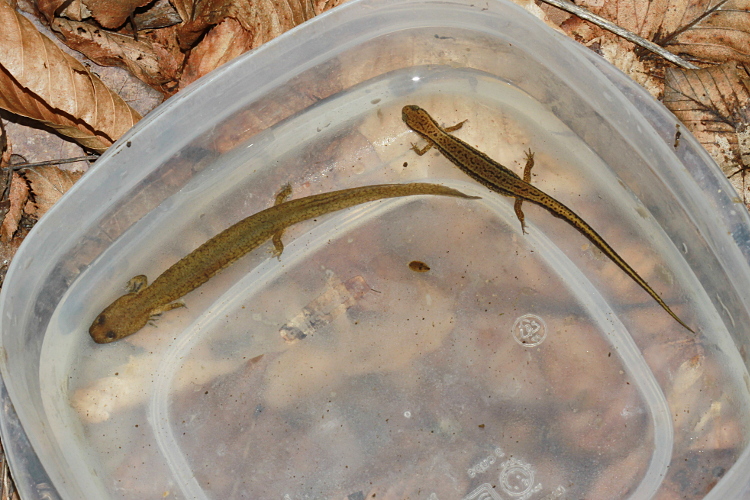
A couple of salamanders found under a good-sized rock
that was under water.
A Northern Spring Salamander (Gyrinophilus porphyriticus porphyriticus)
larva (left) and a Southern Two-lined Salamander (Eurycea cirrigera)
(right). The latter is looking pretty plump --
I'm quite sure that it is gravid.
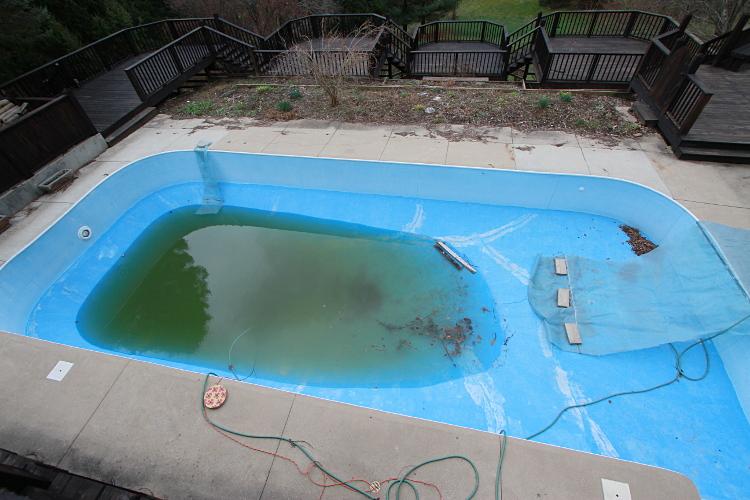
Our pool, on 25 February.
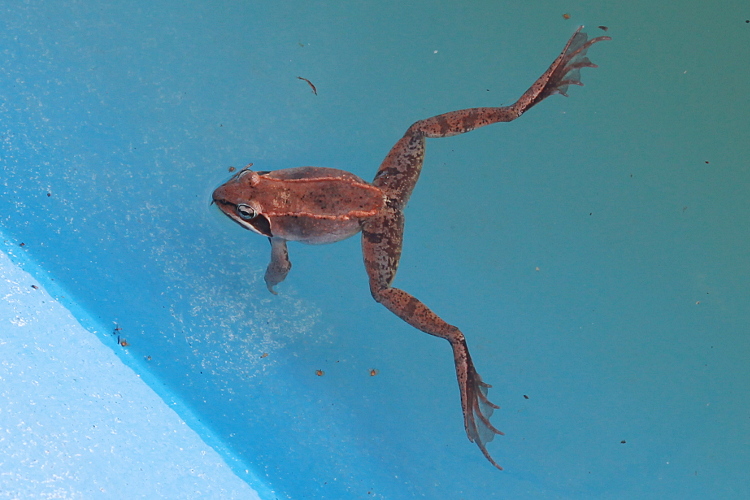
A Wood Frog (Rana sylvatica), hanging out.

More Wood Frogs, just chillin'.
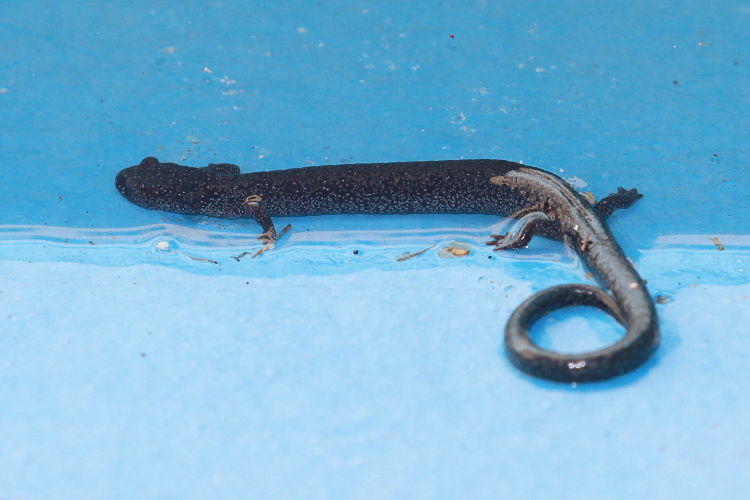
A Ravine Salamander (Plethodon electromorphus), as spotted at the
waterline. I questioned whether or not it could get out on its own, so I
“rescued” it.
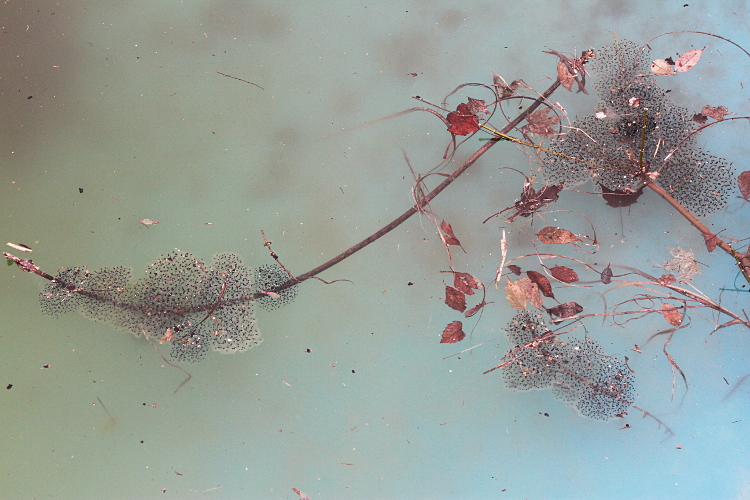
Wood Frog eggs. That's gonna be a lot of tadpoles...
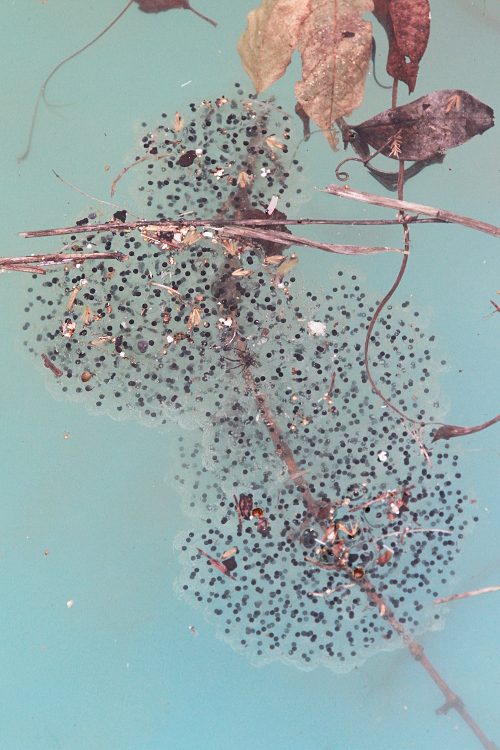
A closer look at some of the Wood Frog eggs. These egg masses were laid
a couple of days before.
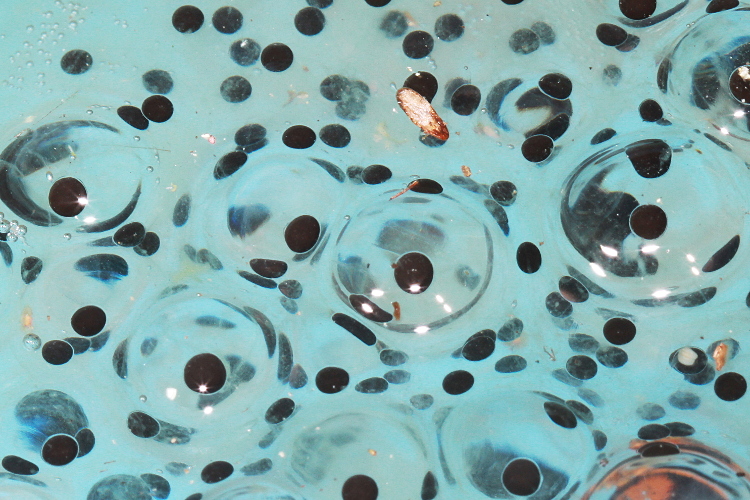
A closer look at some freshly-laid eggs.
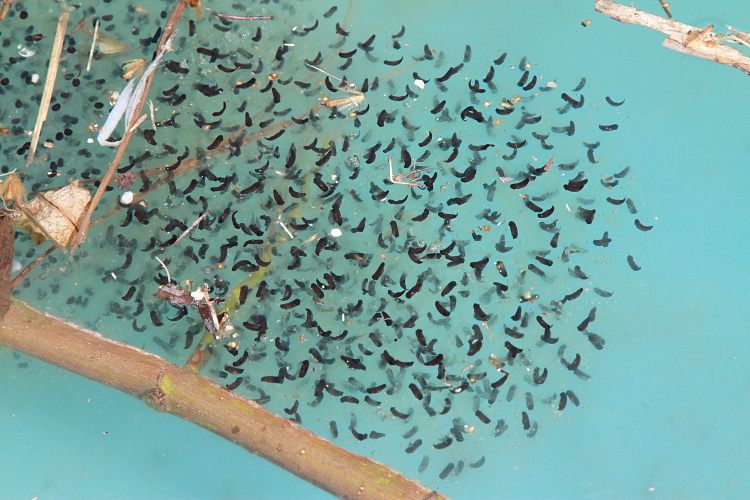
These eggs were laid about two weeks prior and are nearly ready to hatch.
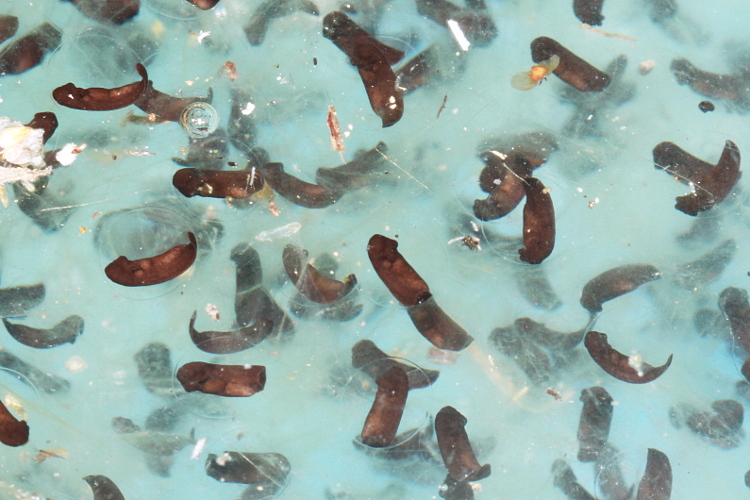
A closer look at the mature eggs.
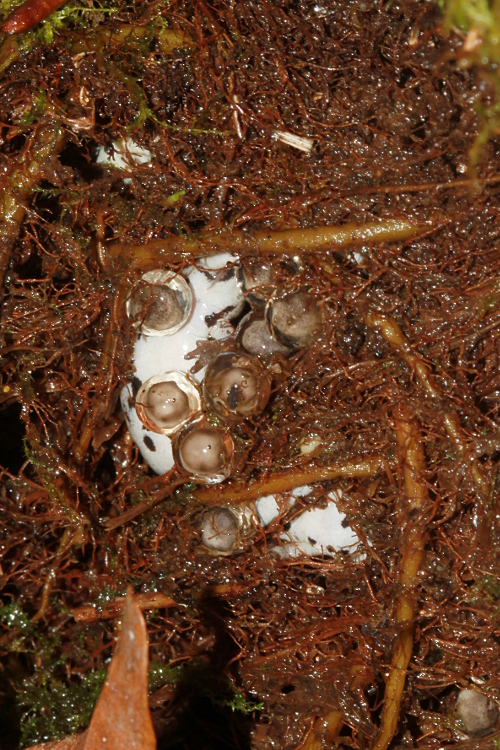
A nesting Four-toed Salamander (Hemidactylium scutatum),
as found in a thick clump of mass on February 25.
This is the earliest that I have ever seen this in Ohio.
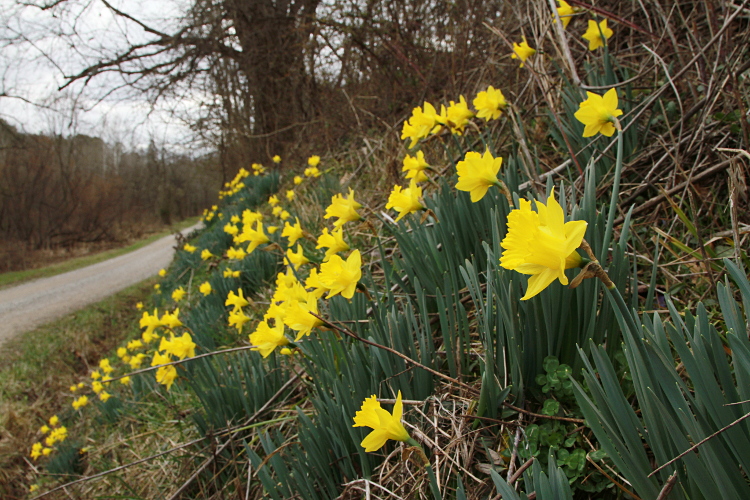
The daffodils were also blooming on February 25 -- again very early.
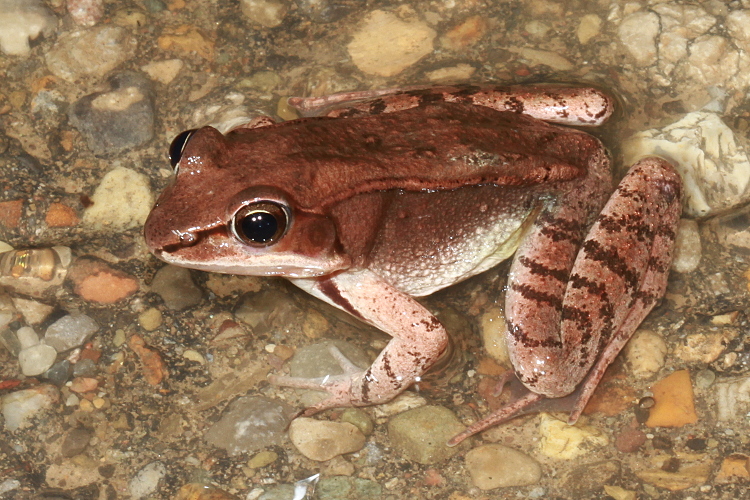
A Wood Frog (Rana sylvatica) seen with Roxanne on a rainy night.
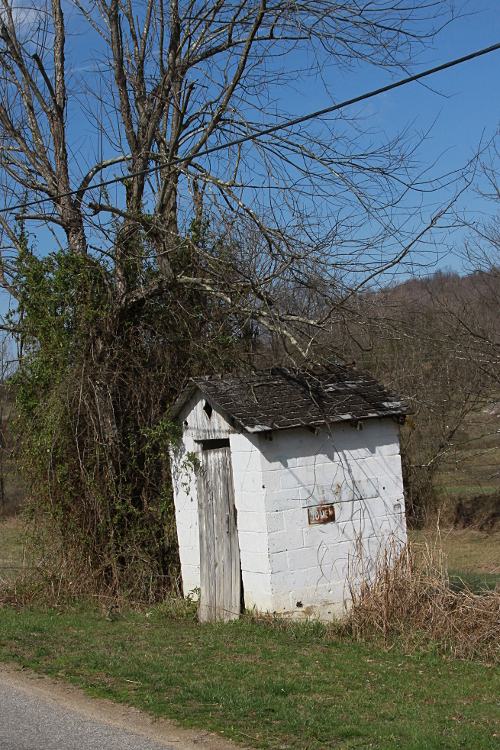
A roadside outhouse. The sign is a bit hard to read, but it says
“women”.
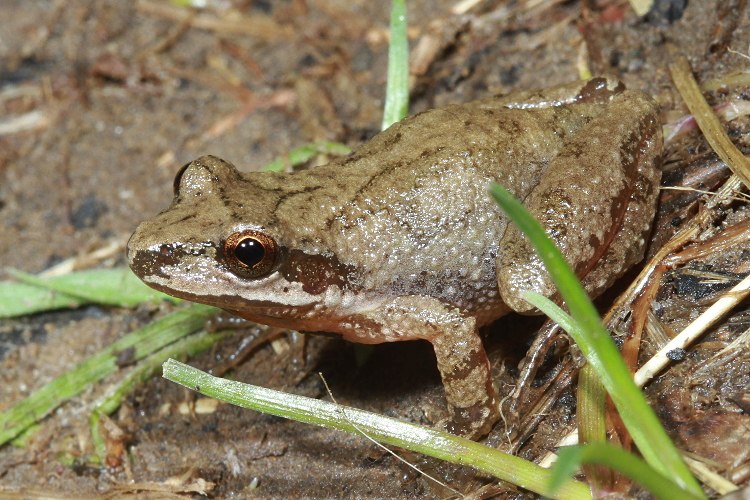
A Mountain Chorus Frog (Pseudacris brachyphona).
Although this species is widely distributed in southeast Ohio, I rarely get
the opportunity to photograph it unless I make a focused effort on it.
There are lots of species that turn up pretty frequently incidentally,
but this is not one of them. By focused effort, I mean you hear
one calling and try to track it down. As in this case it, it usually happens
in the month of March (although I have heard them calling as late as June).
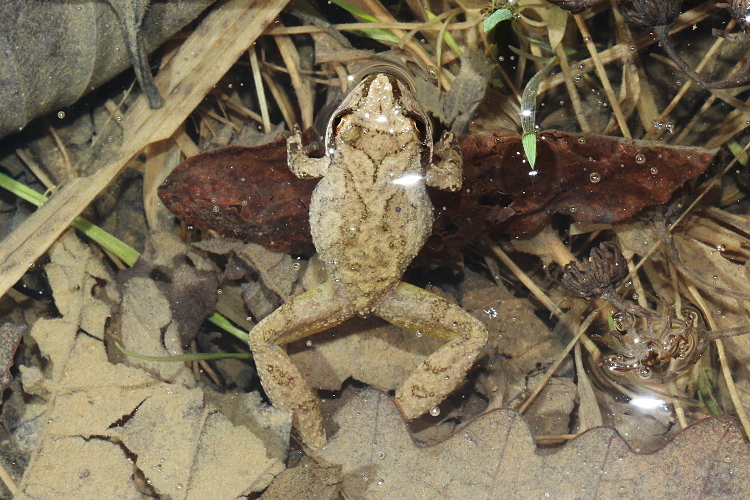
Another look at the same Mountain Chorus Frog.
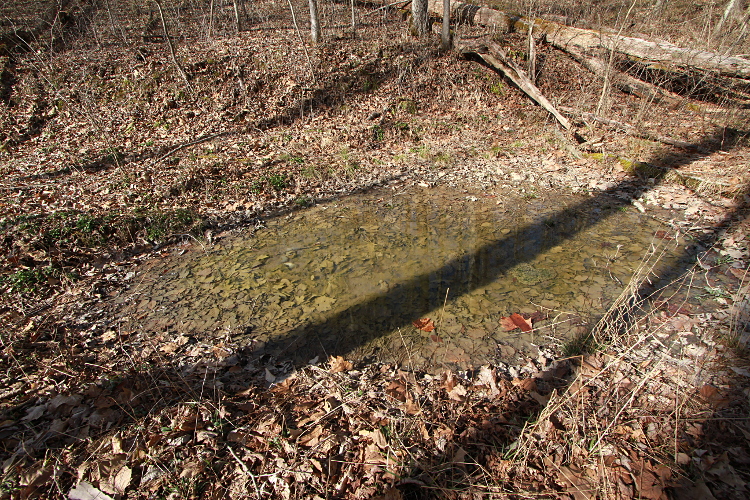
A classic vernal pool filled with Wood Frog and Spotted Salamander
(Ambystoma maculatum) egg masses. Many had already hatched.
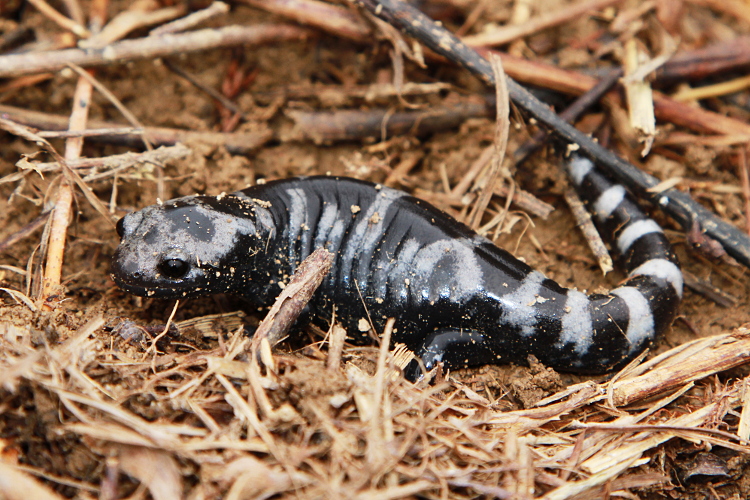
A Marbled Salamander (Ambystoma opacum), as found under a board.
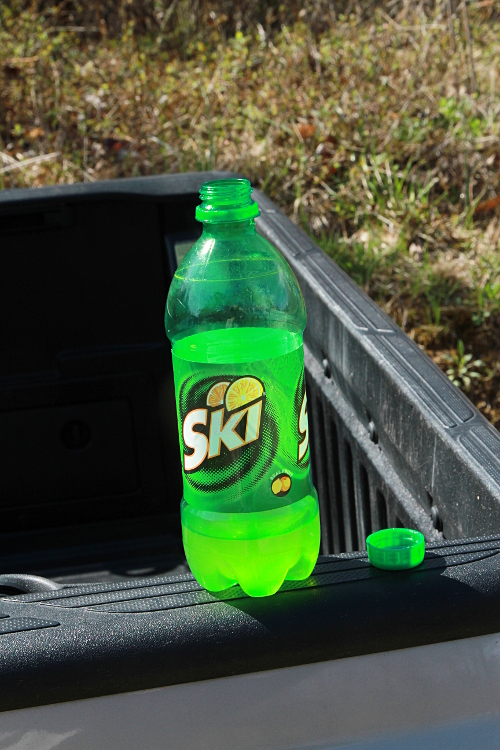
Ski soda used to be bottled in Wellston, a small town in rural southeast Ohio.
I found myself passing through the town one day, so I figured I should have
one (when in Rome...?). I rarely drink soda, and haven't had a Ski in a
few years. I think it's actually pretty good (it's got real fruit juice!).
But it's also got tons of sugar and more caffeine than Mountain Dew.
It's probably not a good thing that you can buy it by the case...
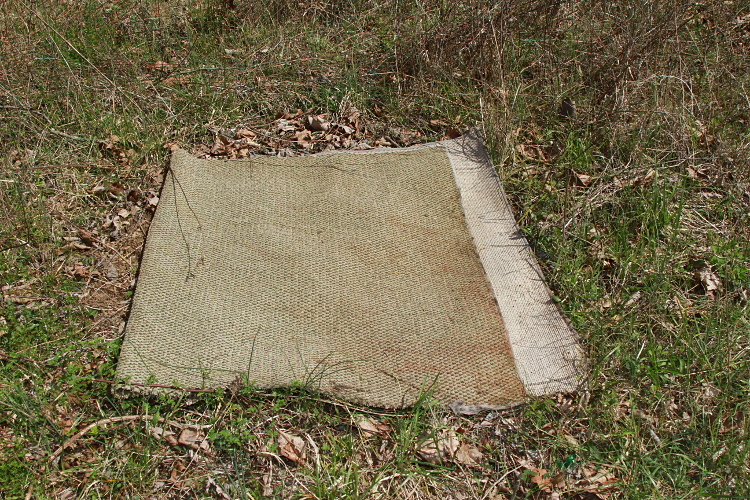
A piece of carpet.

A closer look at the right side of the carpet.
It's a Black Kingsnake (Lampropeltis getula nigra).
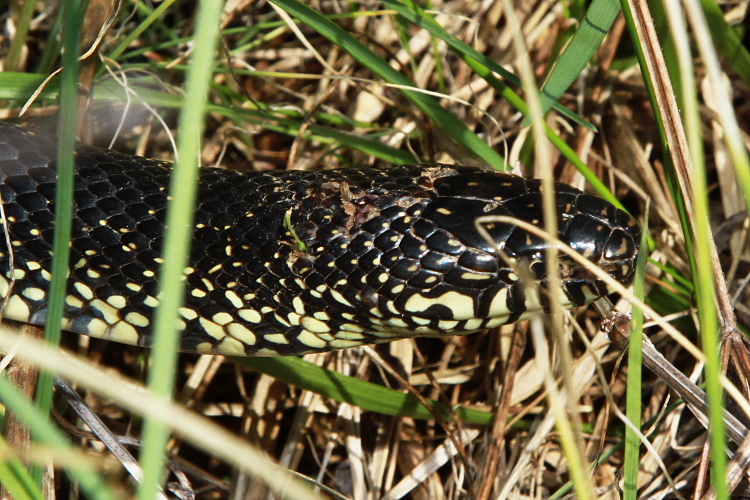
A closer look at the Black Kingsnake.
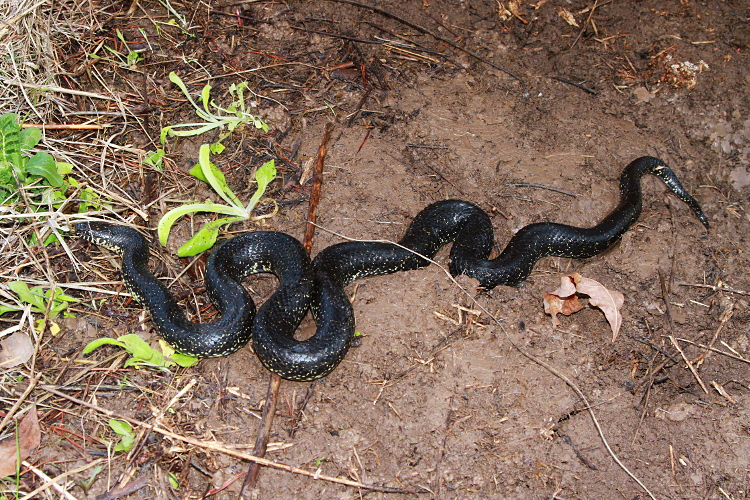
Another Black Kingsnake, as found under a board.
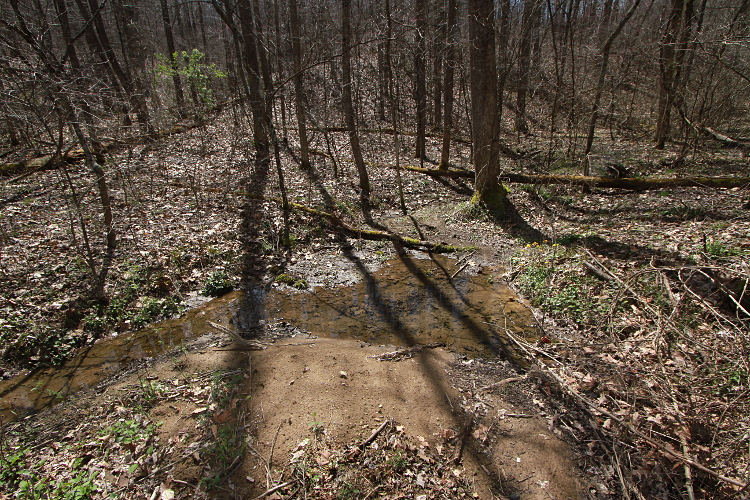
A seepage-fed floodplain pool.
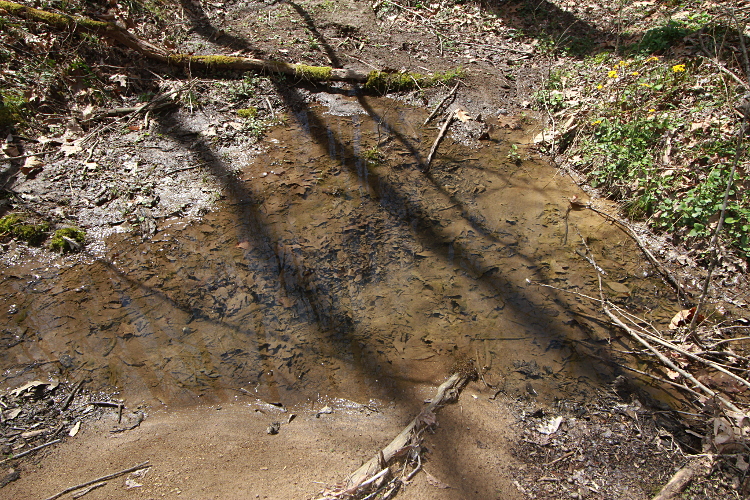
A closer look at where the water seeps out.
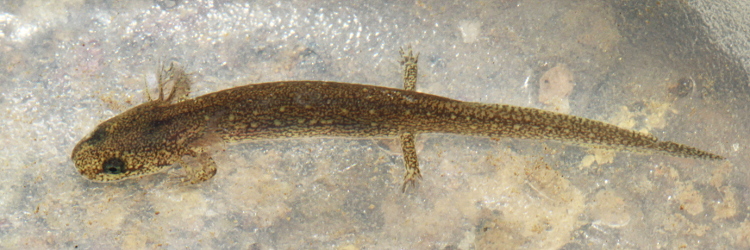
One of two Mud Salamander (Pseudotriton montanus) larvae found
in the pool.
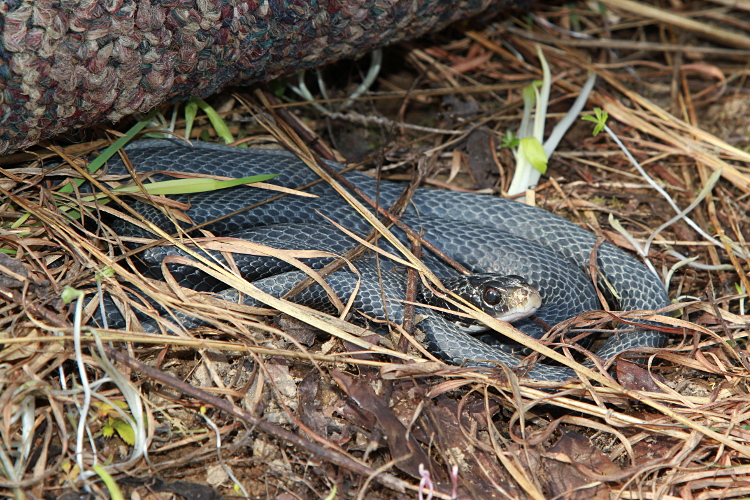
A Black Racer (Coluber constrictor), as revealed under carpet.
It looks like it could use a shed.
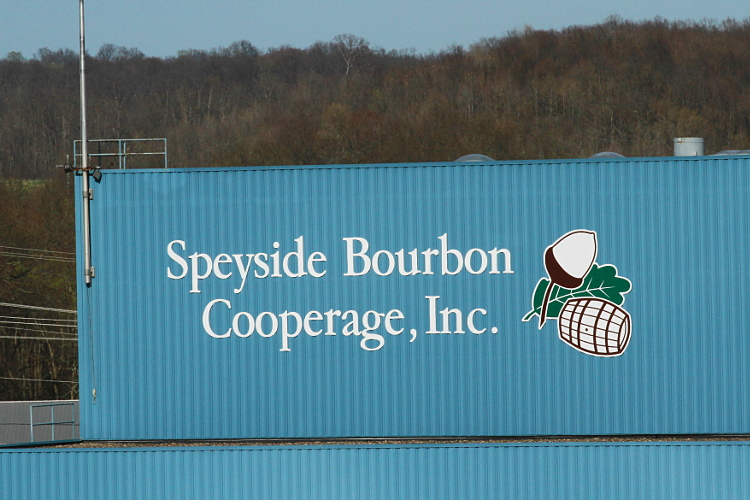
This is kind of cool for several reasons. First is the word
“Cooperage,” which means barrel factory.
Second is that the White Oak, which grows abundantly in
SE Ohio and is the preferred wood for making the staves (another cool word)
for whiskey, bourbon, etc... barrels. Apparently the White Oak imparts
critical flavor and aroma to the aging spirits. The third cool thing is
that this shuttered former cabinet factory in Jackson, OH was recently
re-purposed as a cooperage, creating a number of jobs in a region that
sorely needs them. I hope this business thrives.
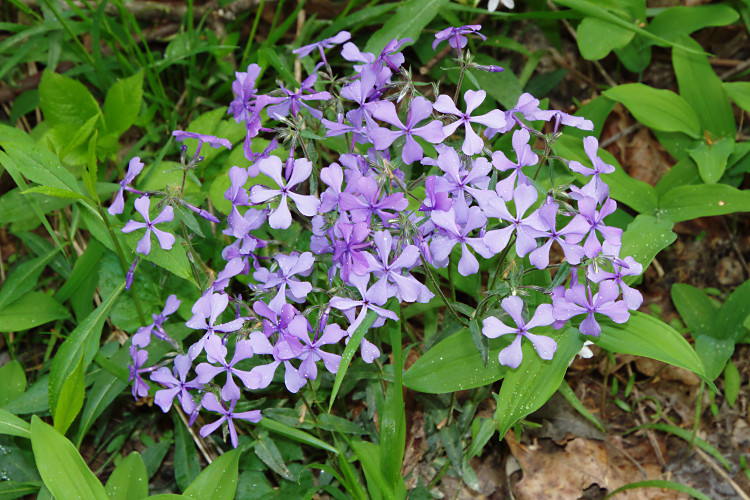
Blue Phlox (Phlox divaricata).
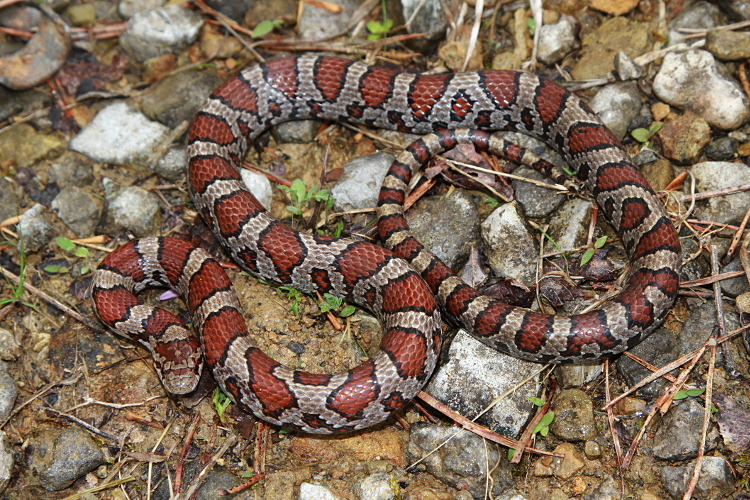
A Milksnake (Lampropeltis triangulum). One of the more colorful
adults I've seen in Ohio.
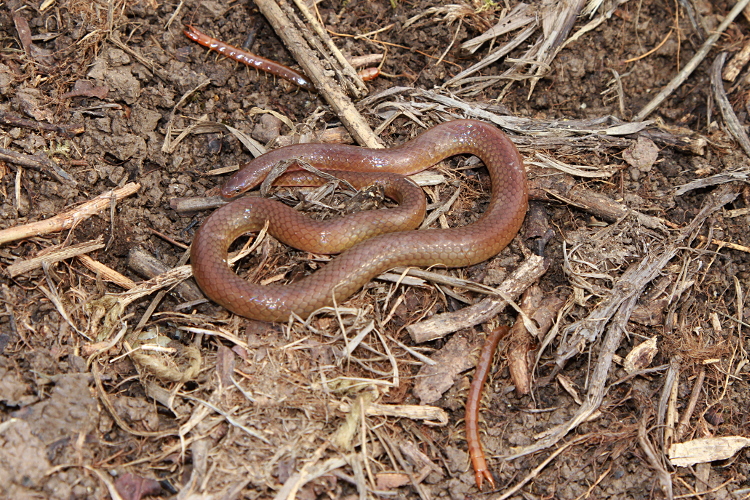
A Worm Snake (Carphophis amoenus), as found under a rock slab.
I think it's pretty cool that two centipedes wound up in the photo as well.
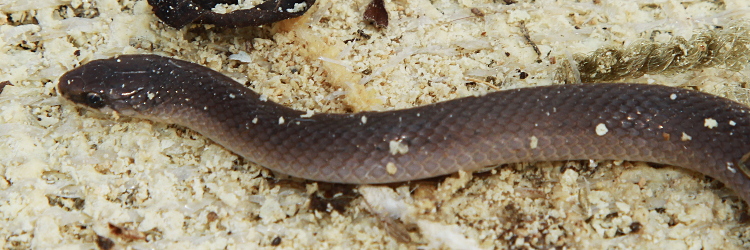
A Smooth Earth Snake (Virginia valeriae), as found between folds
of carpet.

A carrion (burying) beetle that I found. Those who know better than I
tell me that it is Nicrophorus sayi. Interesting critter.
There is a similar species, the American Burying Beetle, that is
very endangered.
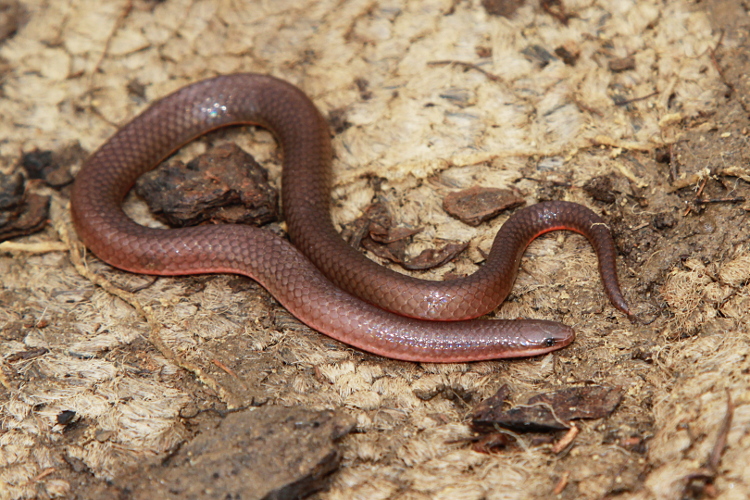
A Worm Snake (Carphophis amoenus), as found between folds of carpet.
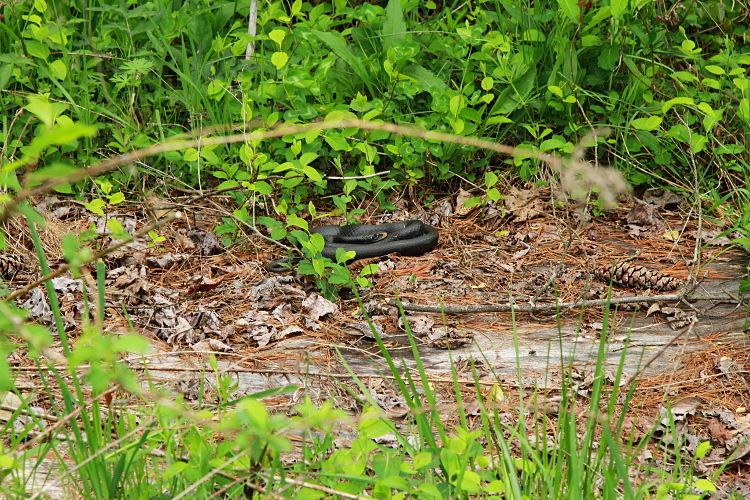
A Black Racer (Coluber constrictor), as spotted.
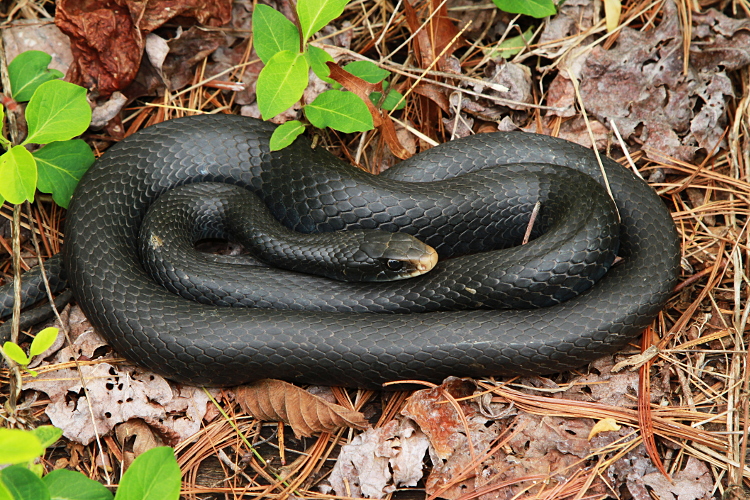
A closer look at the racer.
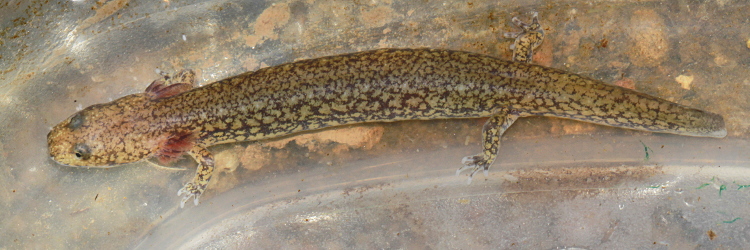
A larval Northern Spring Salamander
(Gyrinophilus porphyriticus porphyriticus) found on a friend's
property northeast of Athens.
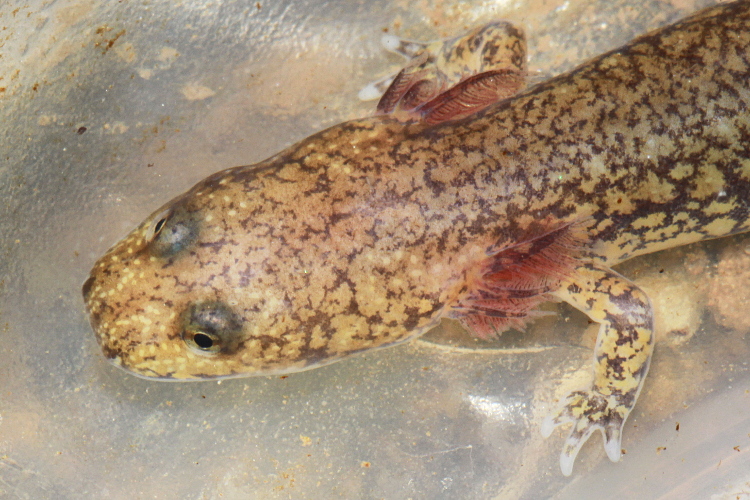
Another look at the Spring Salamander.
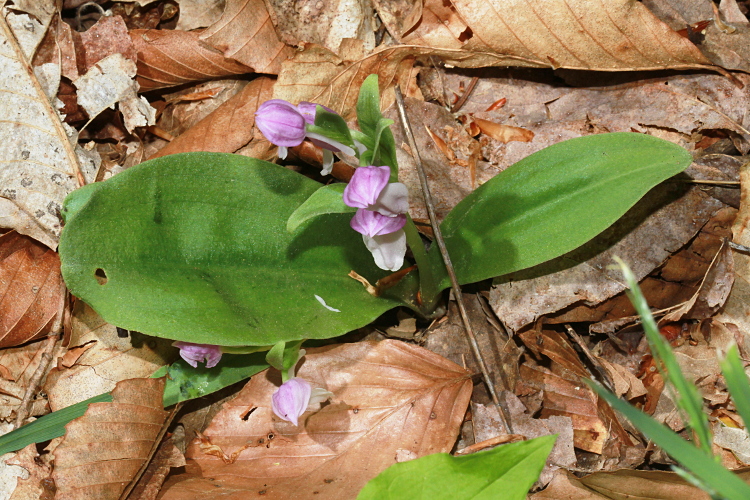
Showy Orchid (Orchis spectabilis).
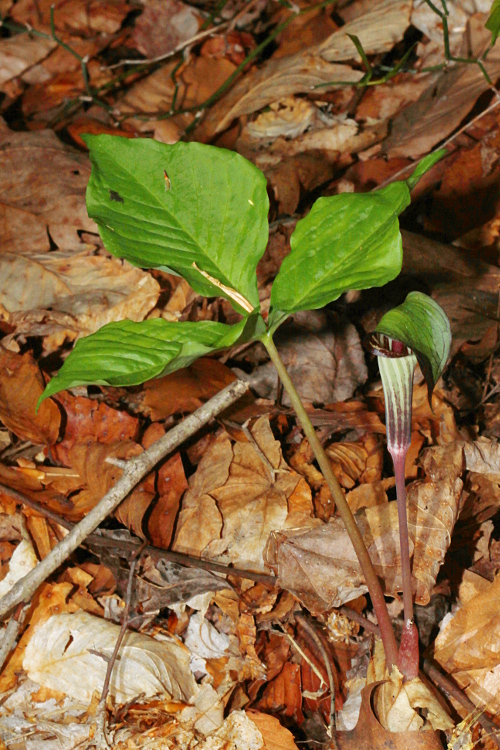
Jack-in-the-Pulpit (Arisaema triphyllum).
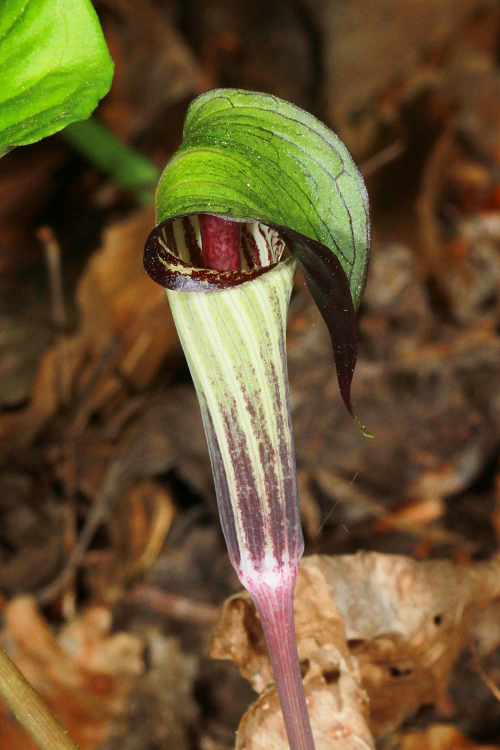
A closer look at the Jack-in-the-Pulpit.

A Bold Jumper Spider (Phidippus audax) dragging a tent caterpillar.
This was found by Rox in the garden.
Considering this and their jumping ability, these spiders are pretty
much superheros!
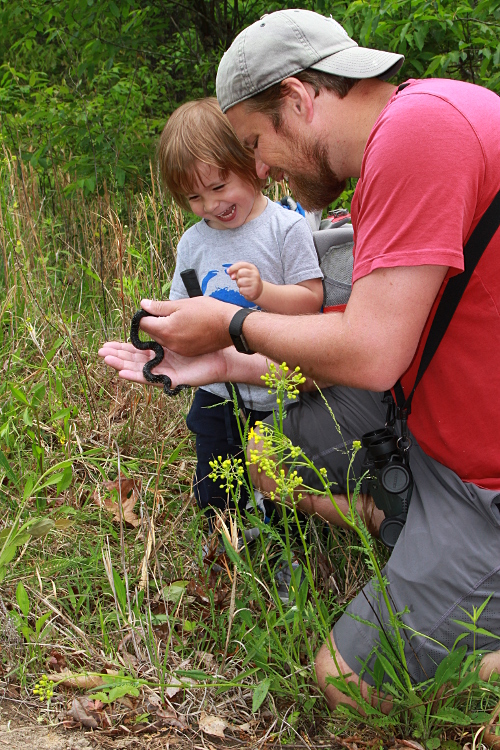
My friend Jason and his son Beckett, checking out a Black Kingsnake.
It was nice that they (and Molly) were able to get back down to Athens.
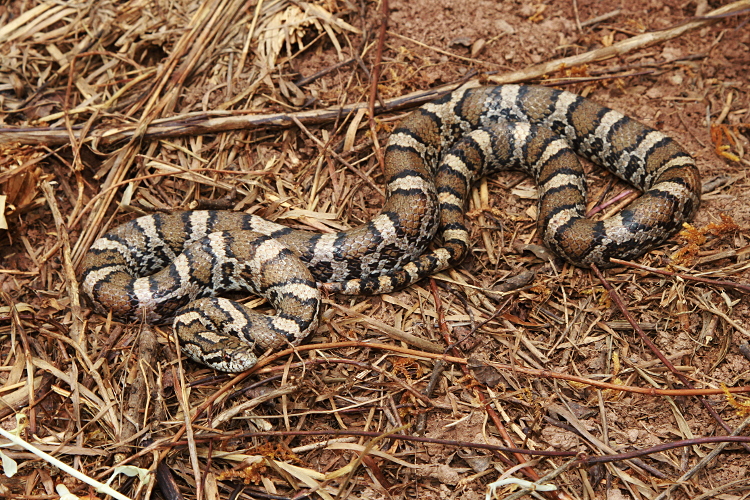
A Milksnake (Lampropeltis triangulum), as found under cover.
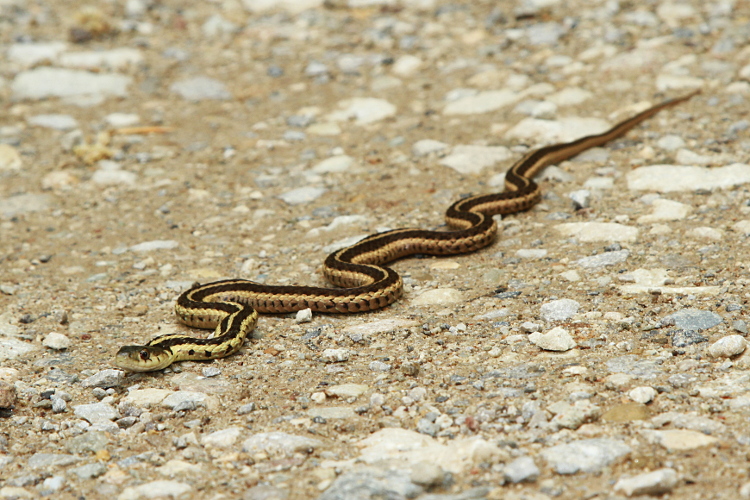
A Common Gartersnake (Thamnophis sirtalis), as found on a road.
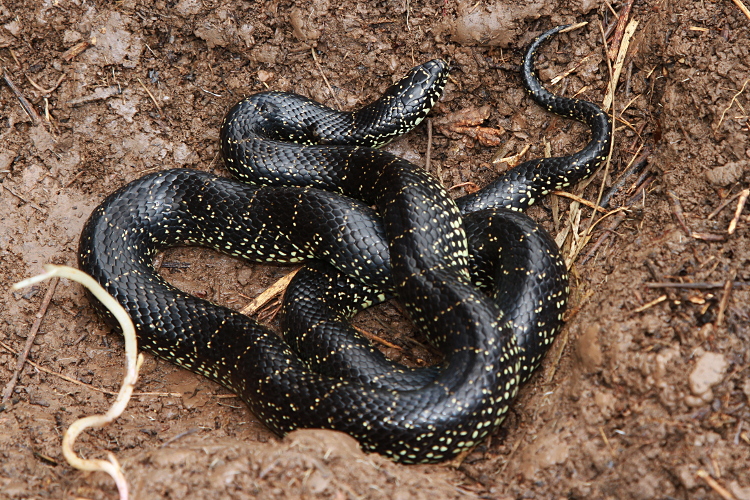
A Black Kingsnake (Lampropeltis getula nigra).

A couple of young snakes, as found under a rock slab along a small
creek here in Athens. The one on the left is a
Queen Snake (Regina septemvittata) and the one on the right
is Northern Watersnake (Nerodia sipedon).
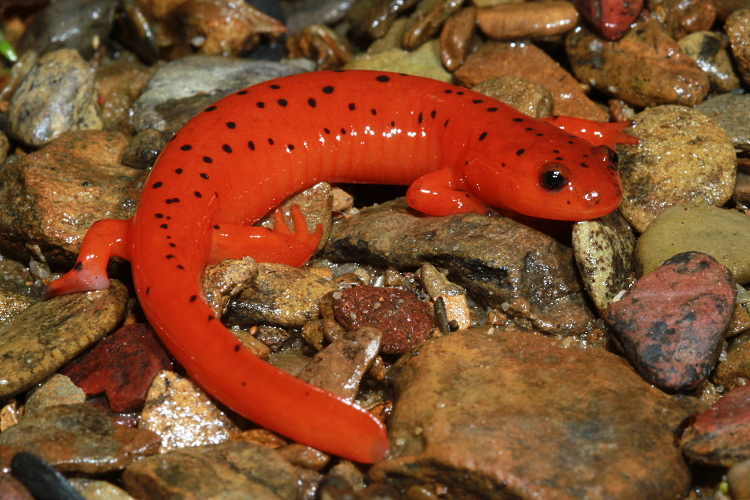
One of the most beautiful amphibians there is, IMO, the
Midland Mud Salamander (Pseudotriton montanus diastictus).
Found by Jason. It had been a few years since I have seen an
adult -- although adult may be pushing it because this guy was
pretty small -- about 3.5'' TL.
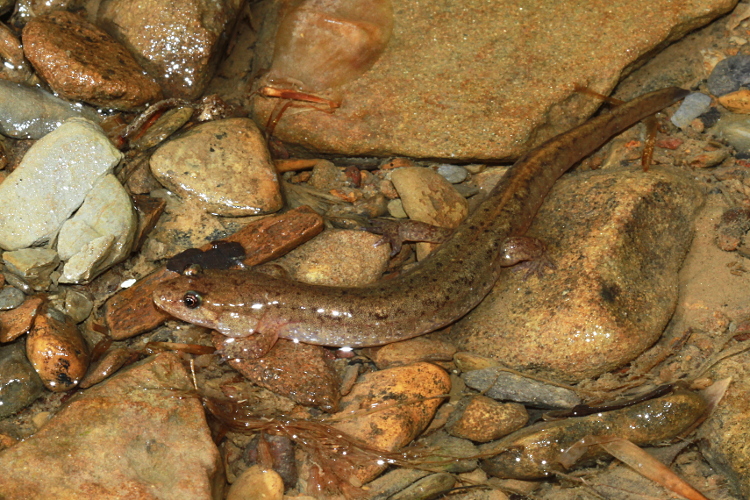
A Northern Dusky Salamander (Desmognathus fuscus).
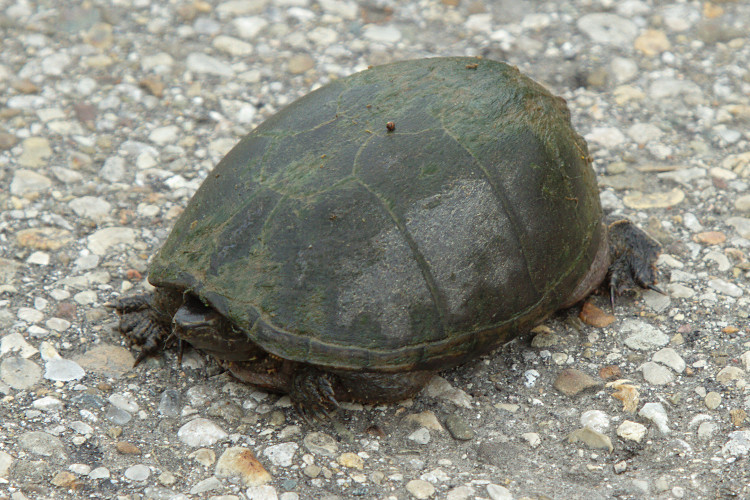
A Common Musk Turtle aka Stinkpot (Sternotherus odoratus), almost
as found crossing a road.
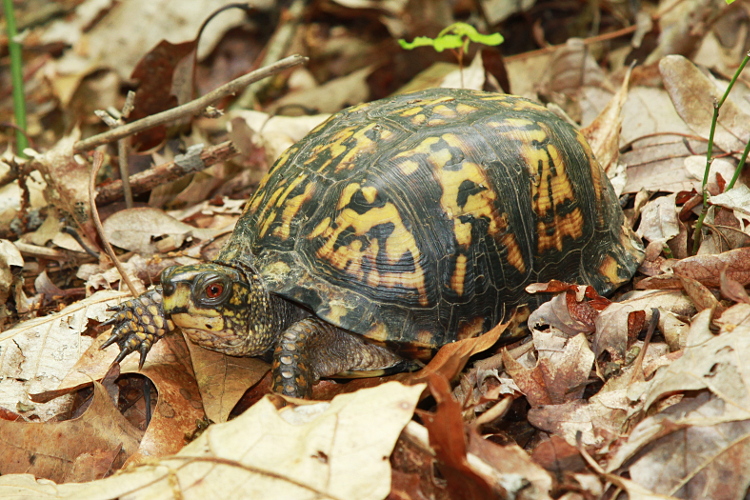
An Eastern Box Turtle (Terrapene carolina), as found in the woods.
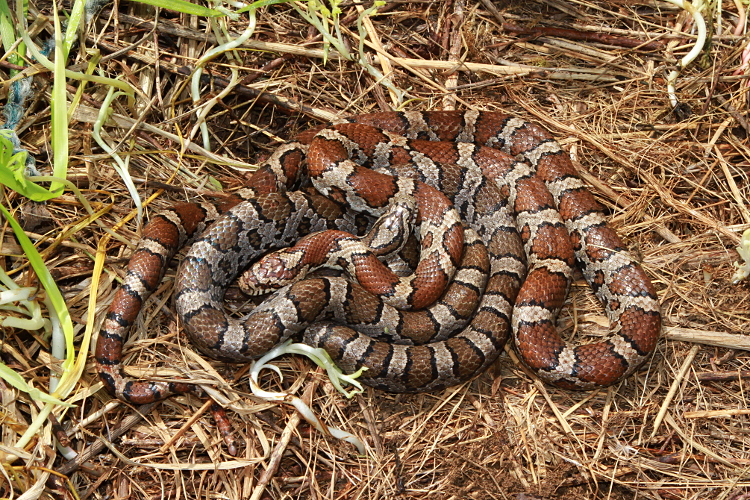
A pair of Milksnakes (Lampropeltis triangulum), as found under cover.
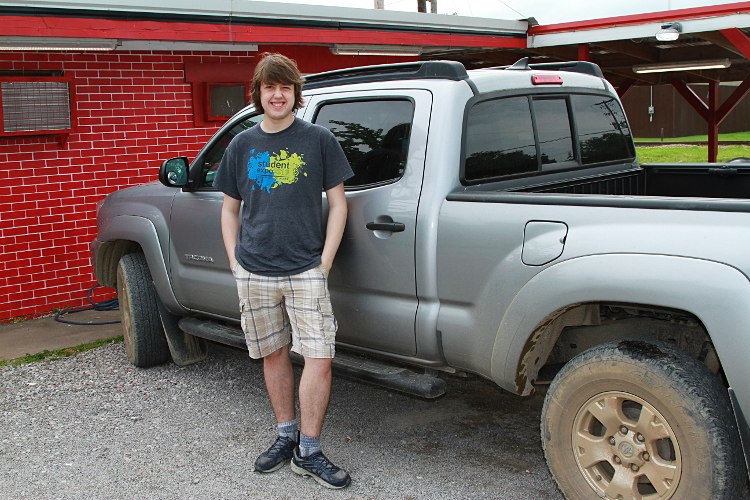
It was nice to get out and hike with Ryan again.
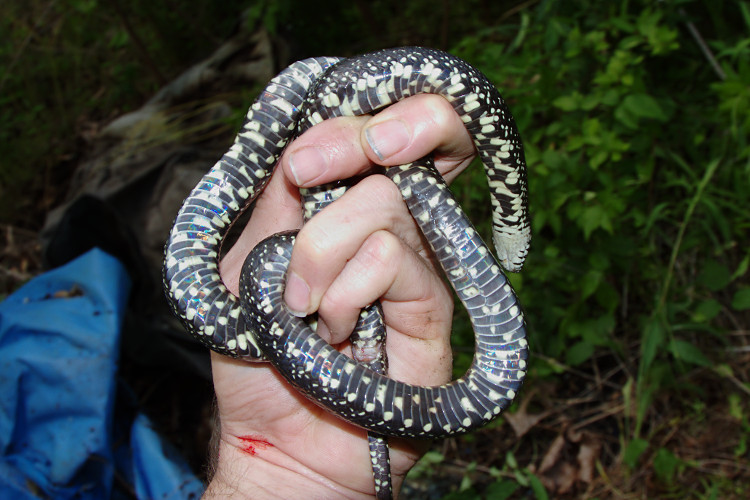
A ventral view of a Black Kingsnake (Lampropeltis getula nigra).
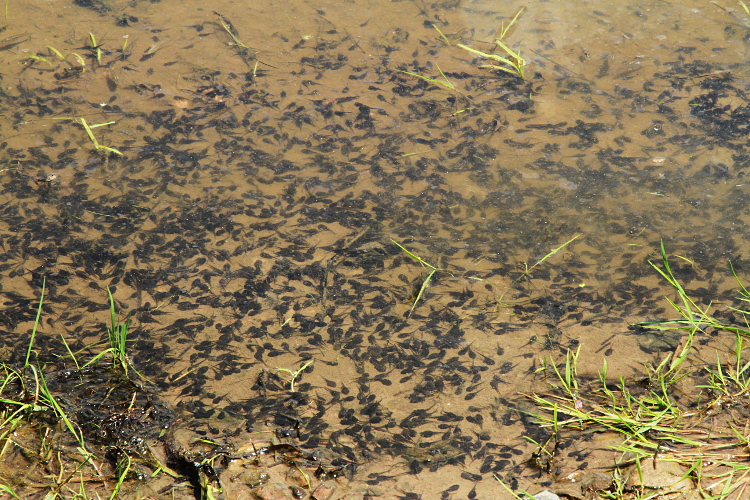
A bunch of American Toad tadpoles (Bufo americanus).
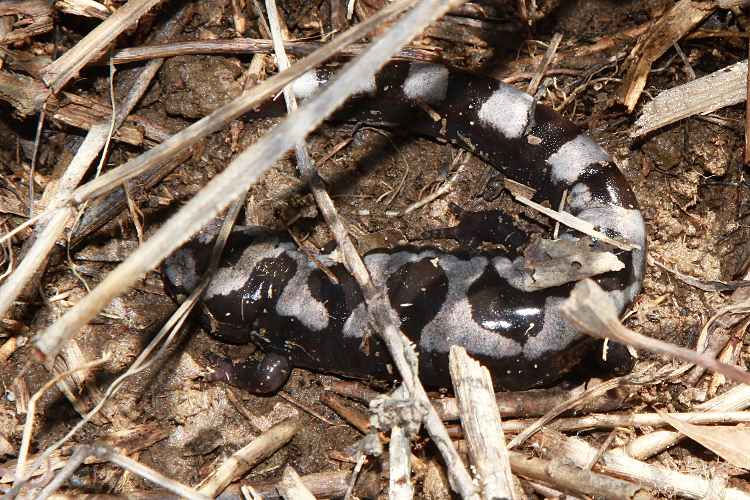
A Marbled Salamander (Ambystoma opacum), as found under a discarded
wading pool.
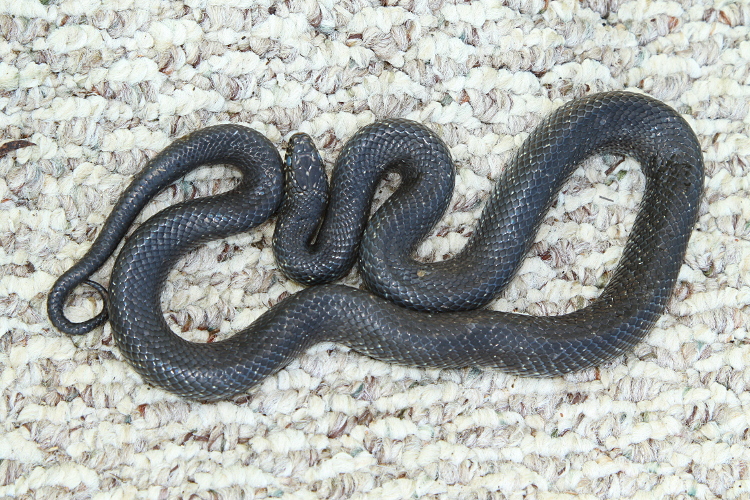
A Black Kingsnake (Lampropeltis getula nigra), as found between
folds of carpet. It is in its shed cycle.
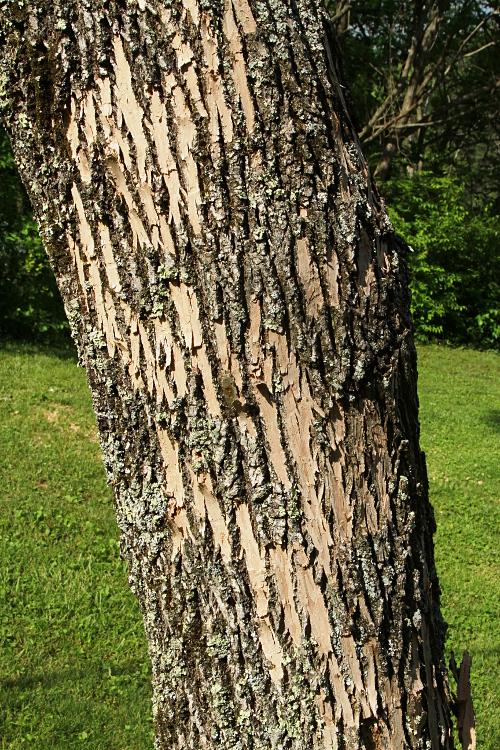
The Emerald Ash Borers have found our property.
The peeling bark, exit holes, and lack of leaves on the
tree when there should be leaves are tell-tale signs.
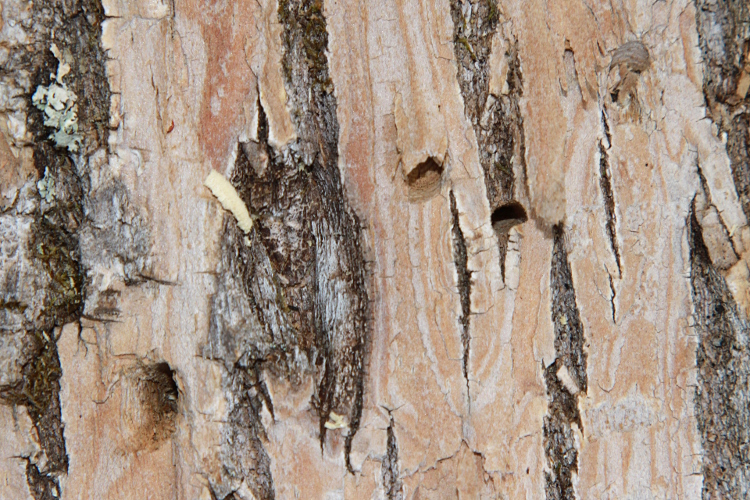
A closer look. The hole in the lower left has been enlarged by a woodpecker.
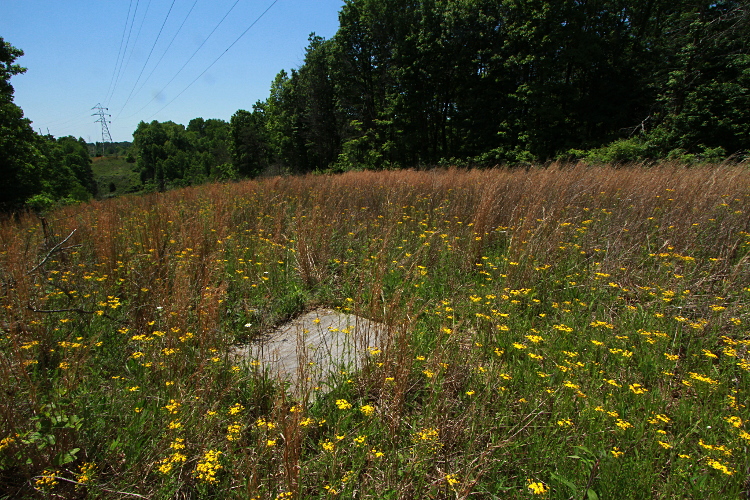
Some nice habitat for Black Kingsnakes.
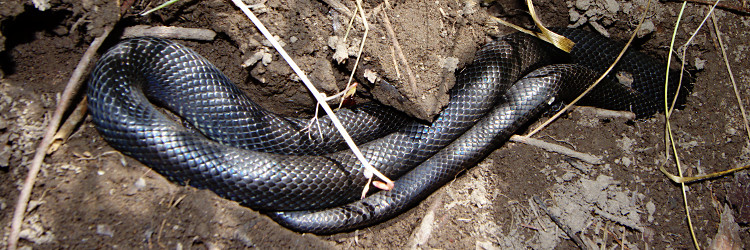
A Black Kingsnake (Lampropeltis getula nigra), as found under cover.
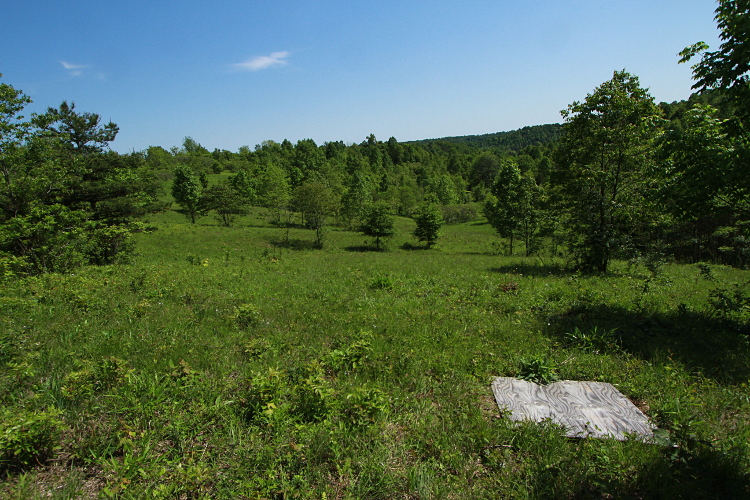
More Black Kingsnake habitat.
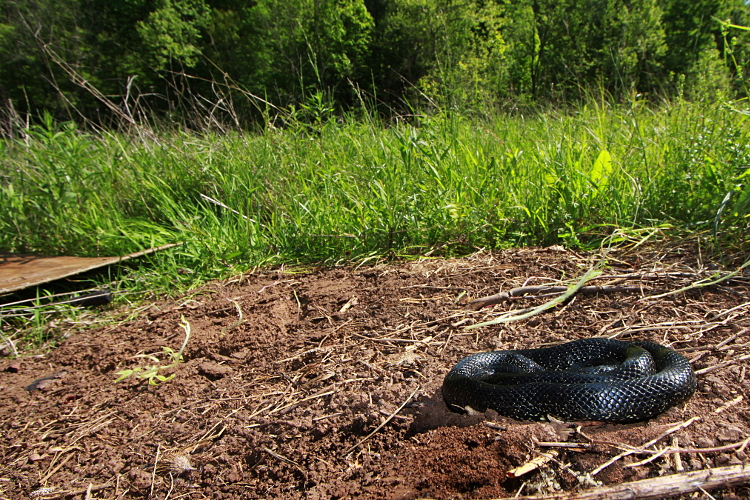
A Black Kingsnake (Lampropeltis getula nigra), as found under a board.
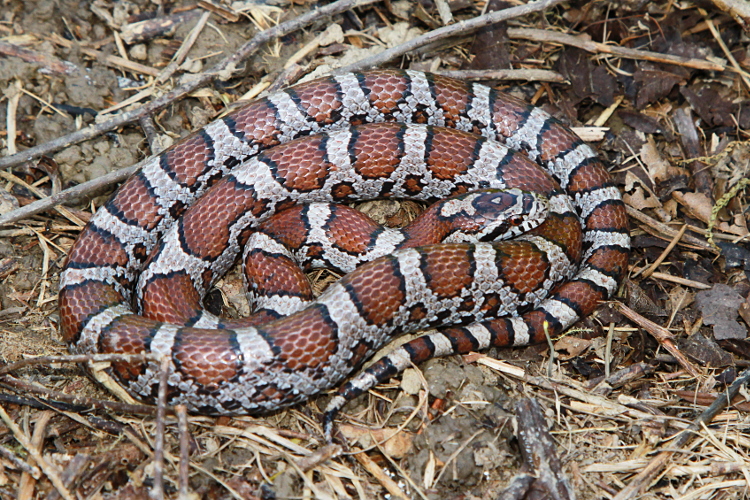
An attractive Milksnake (Lampropeltis triangulum), shown as found.
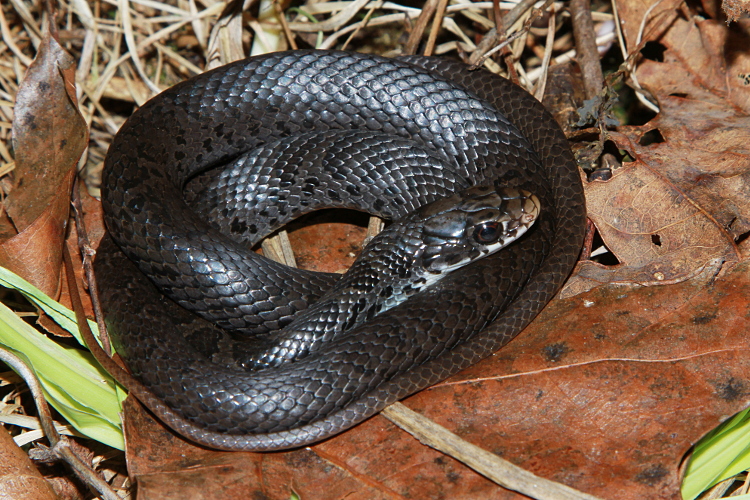
A young Black Racer (Coluber constrictor), shown as found under
cover at dusk. It's just starting to turn black.
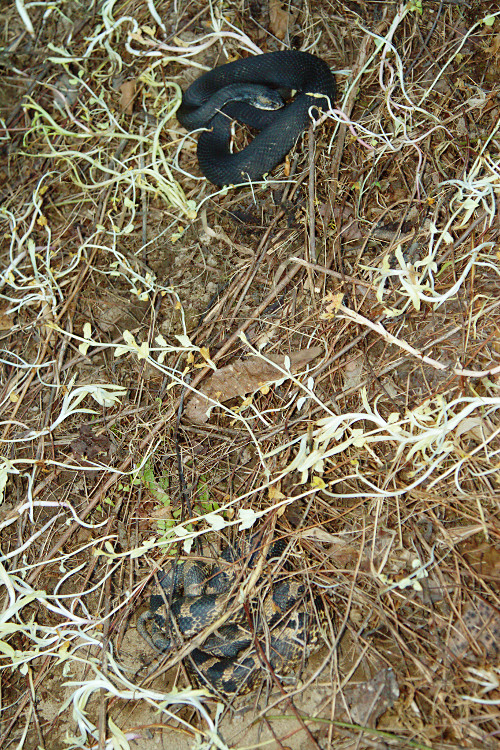
A pair of Eastern Hog-nosed Snakes (Heterodon platirhinos),
shown as found under a board at dusk.

A closer look at one of them. The photo is not great due to the low light.
If I had this to do over again, I would have used full flash -- but
often times, as in this case, you don't get a second chance before the
snakes start moving around.
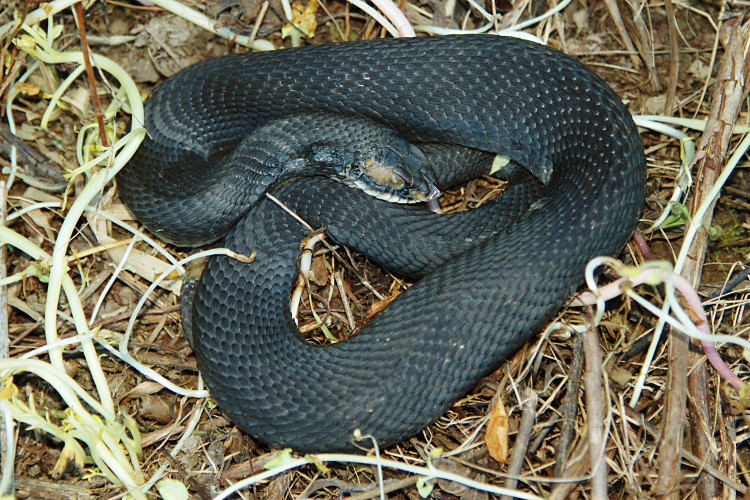
The other Hog-nosed Snake. It seems to have some sort of problem with its eye.
I thought it was mud at the time.
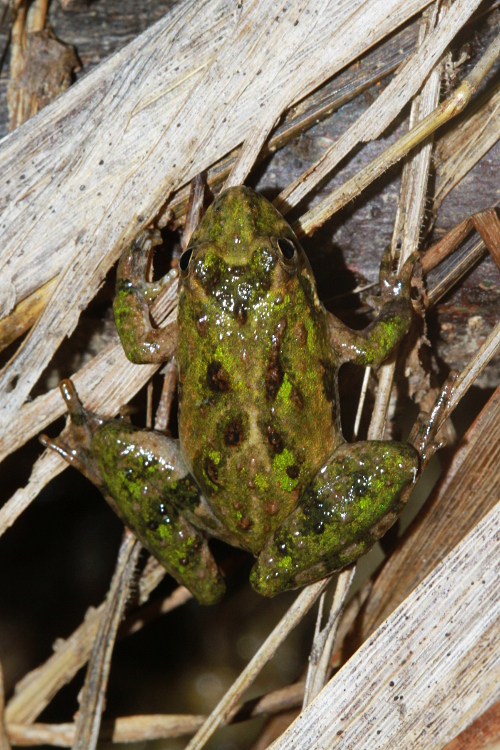
A Blanchard's cricket frog (Acris crepitans blanchardi).
This is a species that I do not see very often.
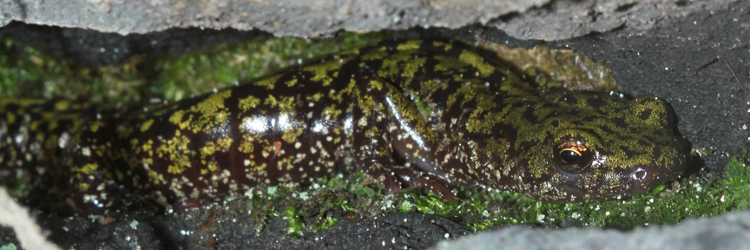
A Green Salamander (Aneides aeneus) as spotted in a rock crevice.
This species barely makes it into Ohio and I see it even less often
than the Cricket Frog.
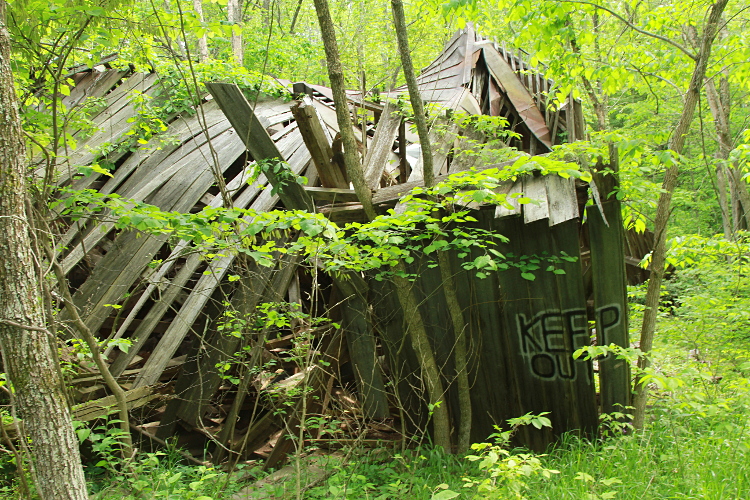
An old barn being reclaimed by mother nature.
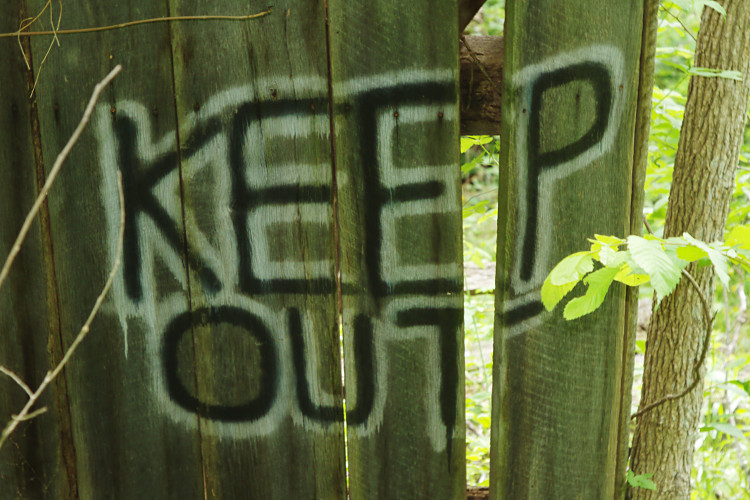
A closer look at the art work.
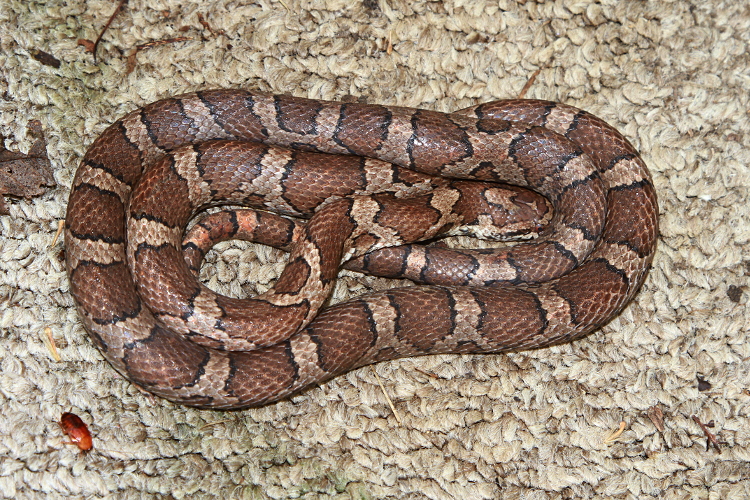
A Milksnake (Lampropeltis triangulum), as found between folds
of carpet.
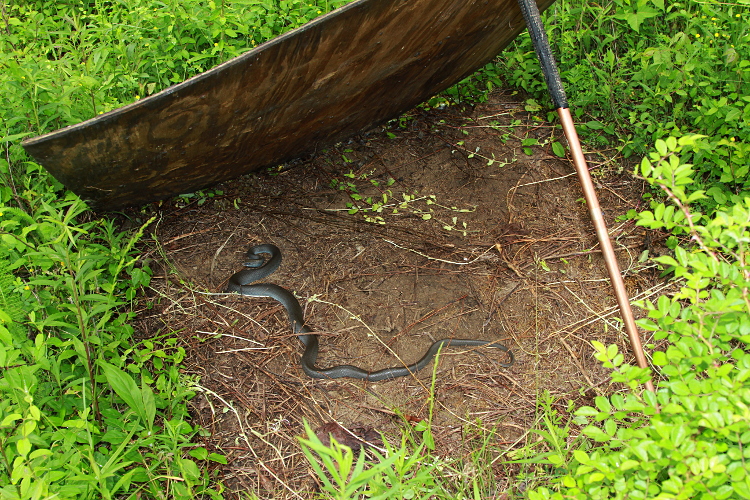
A Black Racer (Coluber constrictor), as found under a board.
This one is more of a “Blue Racer” -- i.e.,
not black -- because it is deep in its shed cycle.
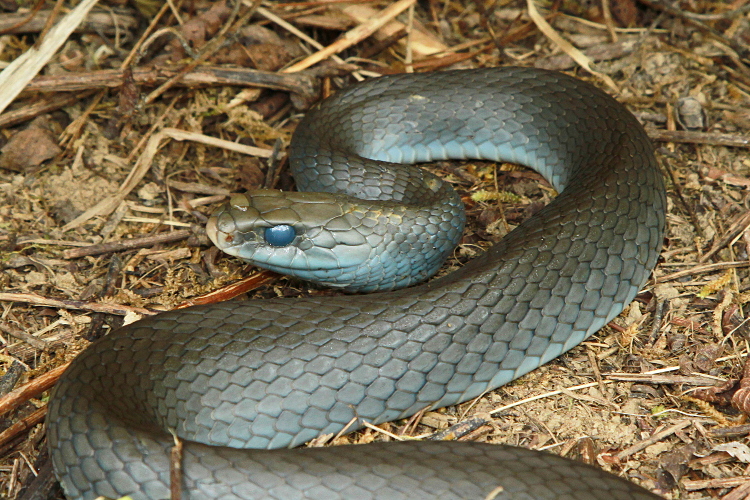
A closer look at the Black Racer.
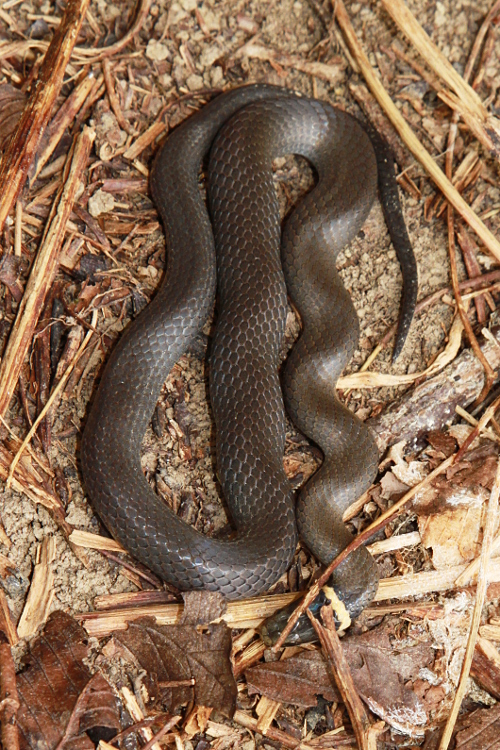
A Ringneck Snake (Diadophis punctatus), as found under a board.
It appears to have a large meal in it, which makes me curious.
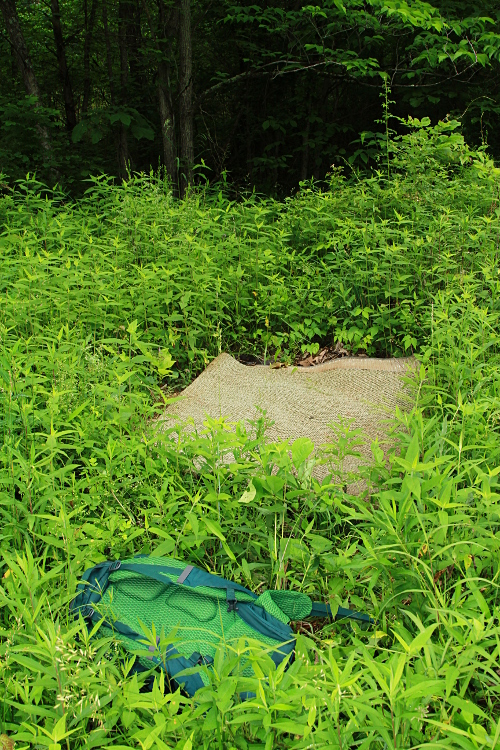
At one point, I walked up on this scene. It had just stopped drizzling.
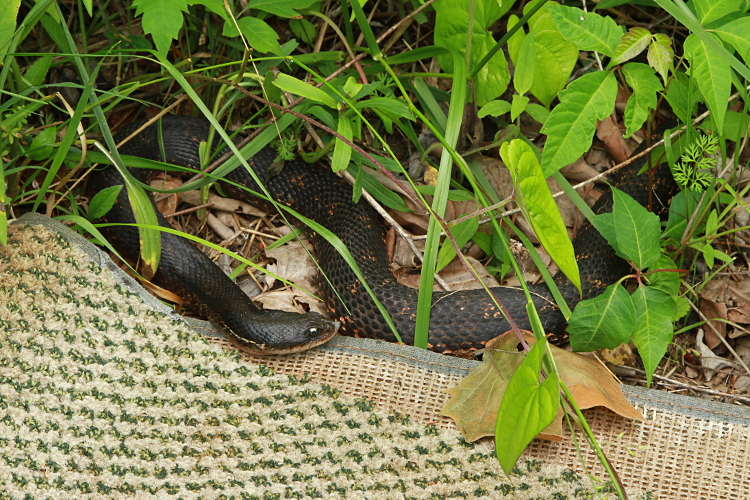
Looking more closely at the edge of the carpet, I saw this:
an Eastern Hog-nosed Snake (Heterodon platirhinos), shown as found.
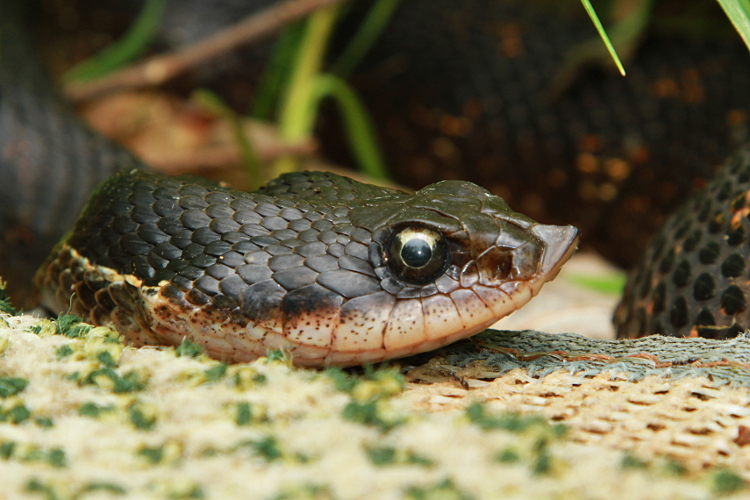
A closer look. The snake never budged and I let it be.
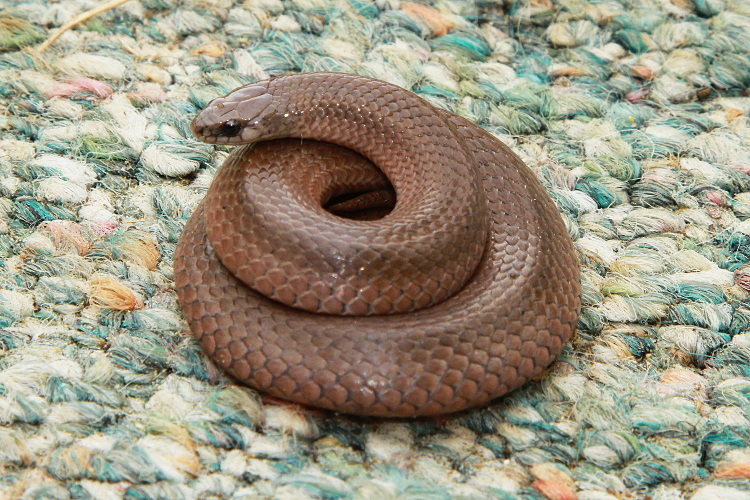
A Smooth Earth Snake (Virginia valeriae) that was found under carpet.
When I posed the snake for a photo, it insisted on assuming this rigid
and unnatural “Tower of Babel” posture.
I have had them do this before.
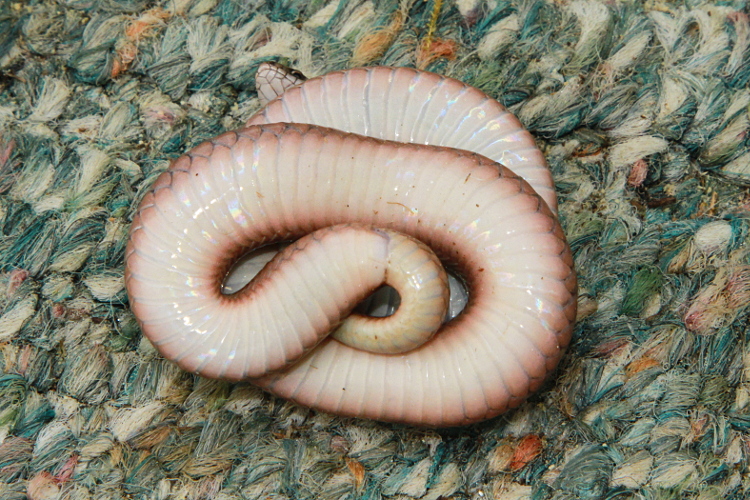
They remain rigid when you flip them over. A good opportunity for a
ventral photo, I suppose.
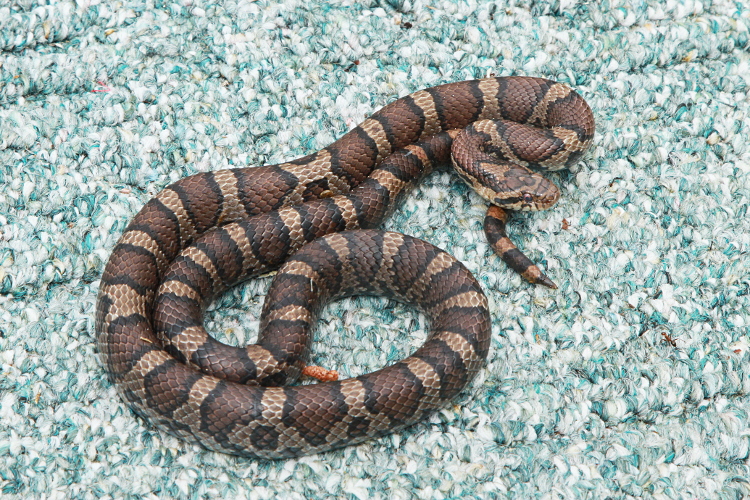
A Milksnake (Lampropeltis triangulum), as found between folds
of carpet.
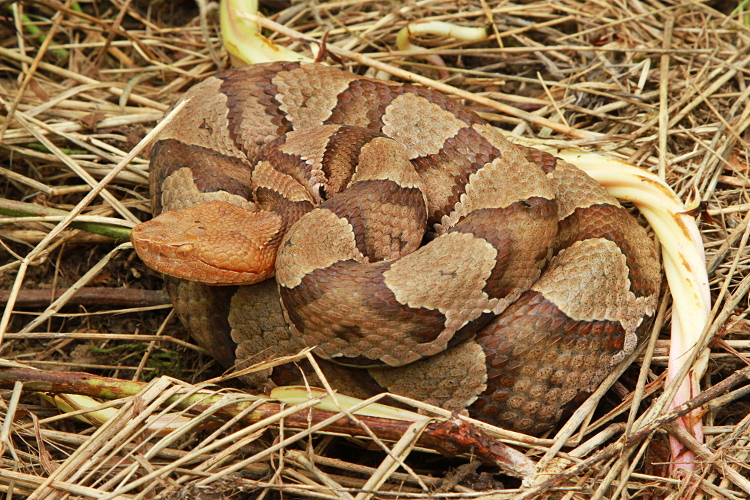
A Copperhead (Agkistrodon contortrix), shown as found under cover.
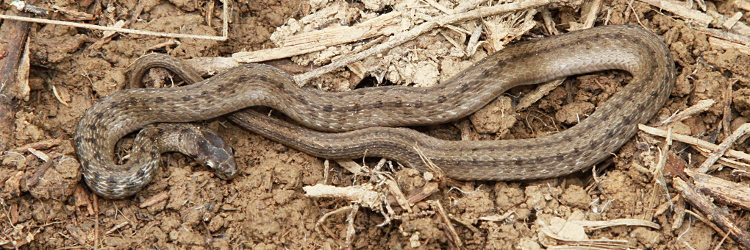
A Dekay's Snake (Storeria dekayi), as found under cover.
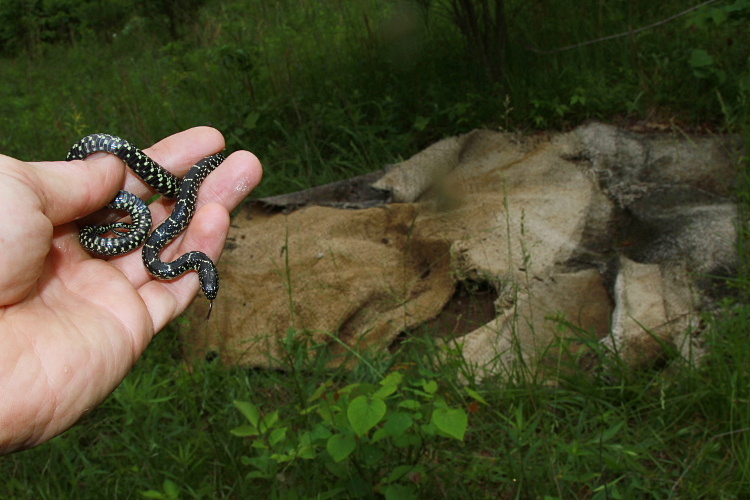
A juvenile Black Kingsnake (Lampropeltis getula nigra),
found in the carpet in the background.
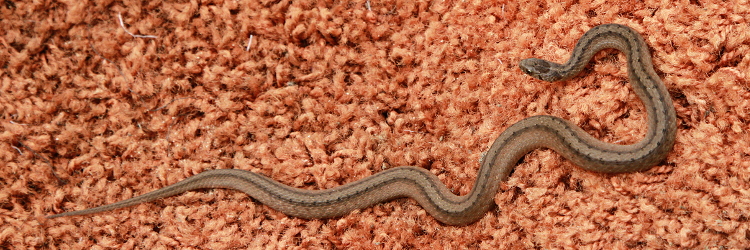
A Dekay's Snake (Storeria dekayi), as found between folds of carpet.
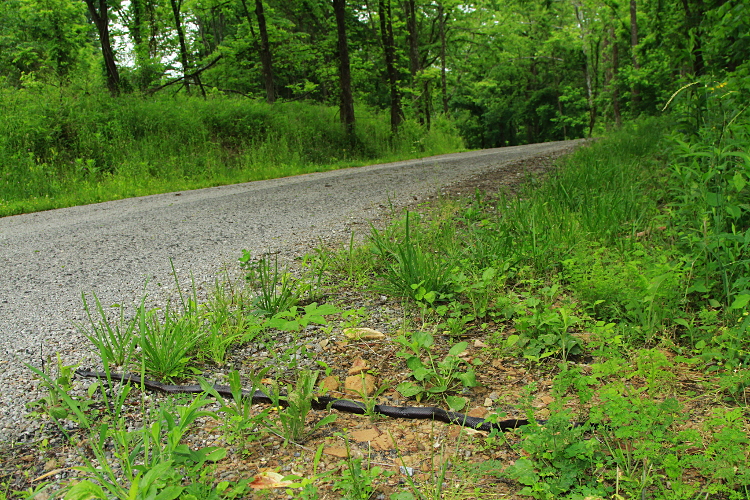
A Black Ratsnake (Elaphe obsoleta), contemplating crossing the road.
It had just stopped raining.
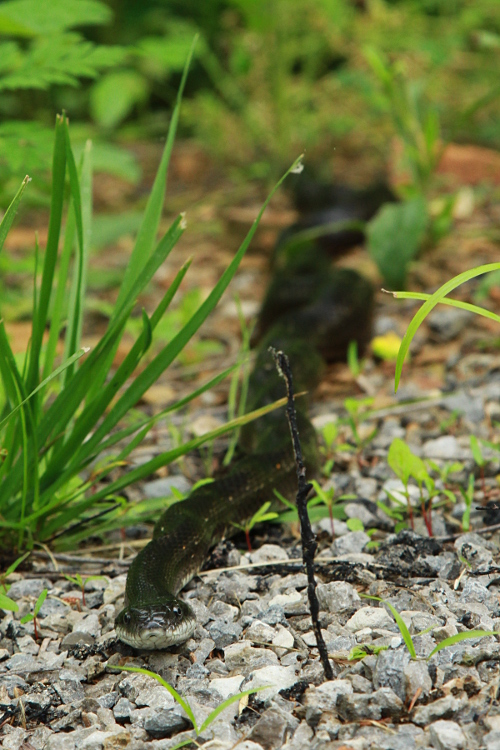
A closer look at the Black Ratsnake.
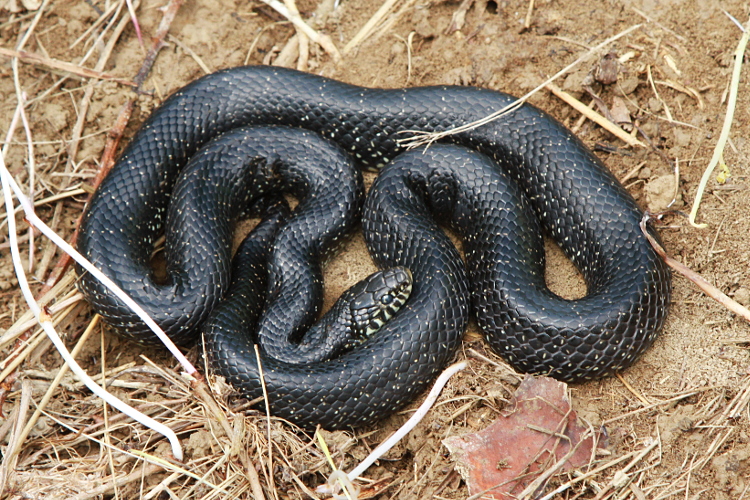
A Black Kingsnake (Lampropeltis getula nigra), as found under a board.
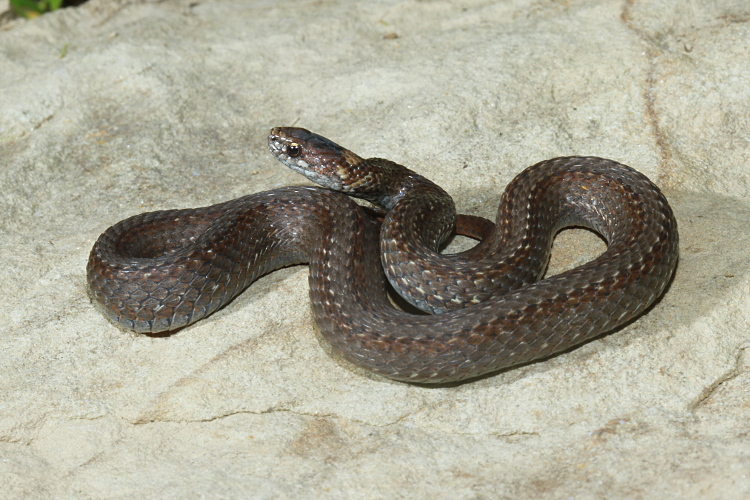
A Red-bellied Snake (Storeria occipitomaculata). I do not see this
species very often.
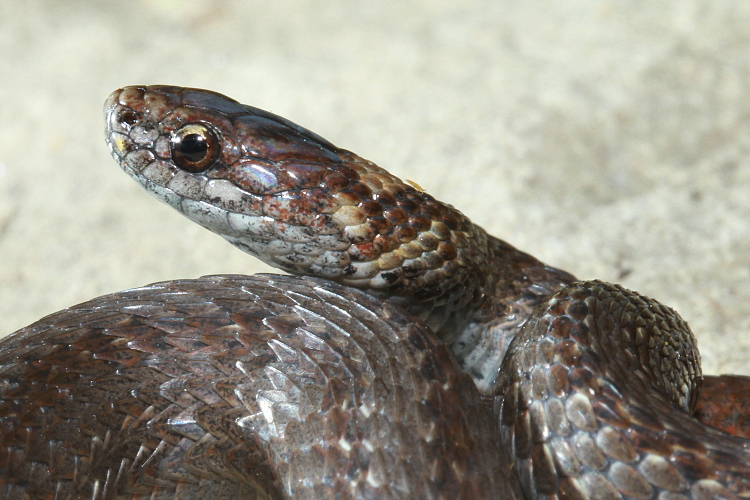
A closer look at the Red-bellied Snake.
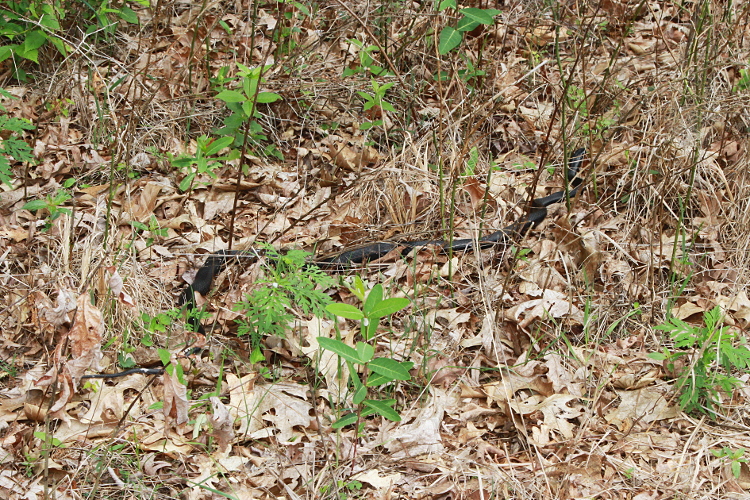
A Black Racer (Coluber constrictor), shown as found.
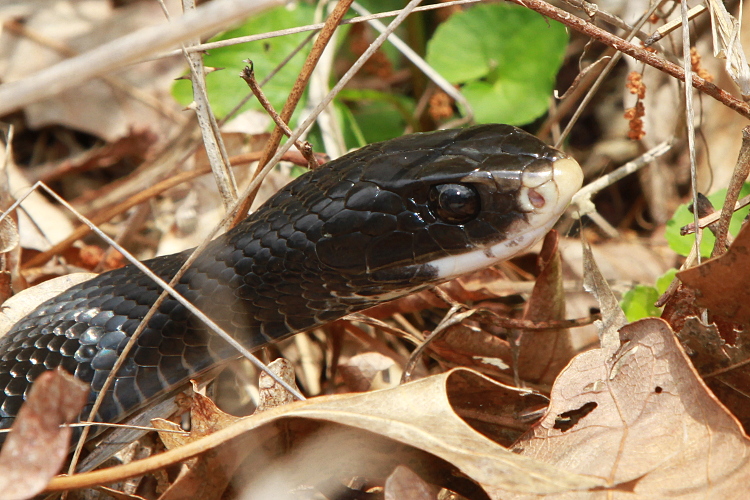
A closer look at the Black Racer.
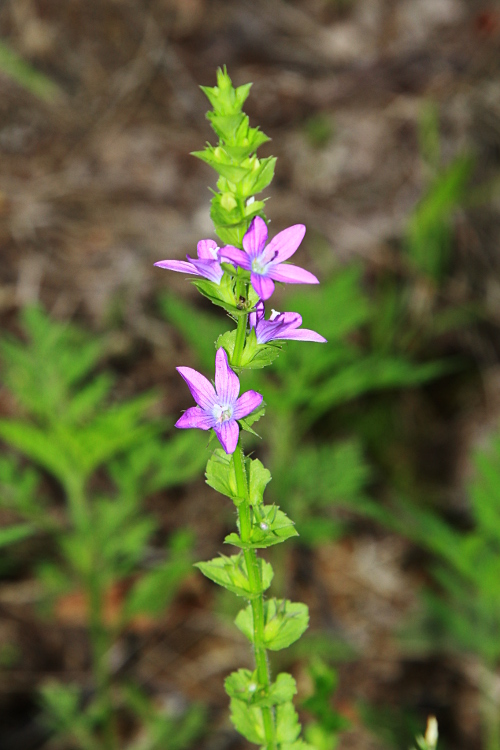
Venus' Looking Glass (Triodanis perfoliata).
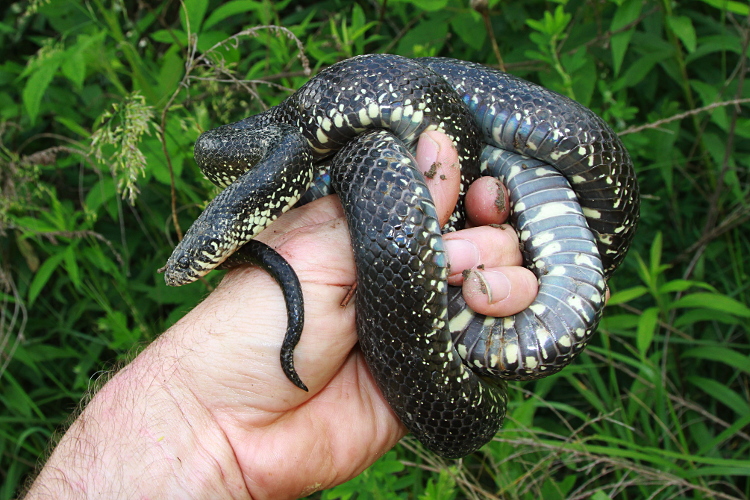
A large Black Kingsnake (Lampropeltis getula nigra).
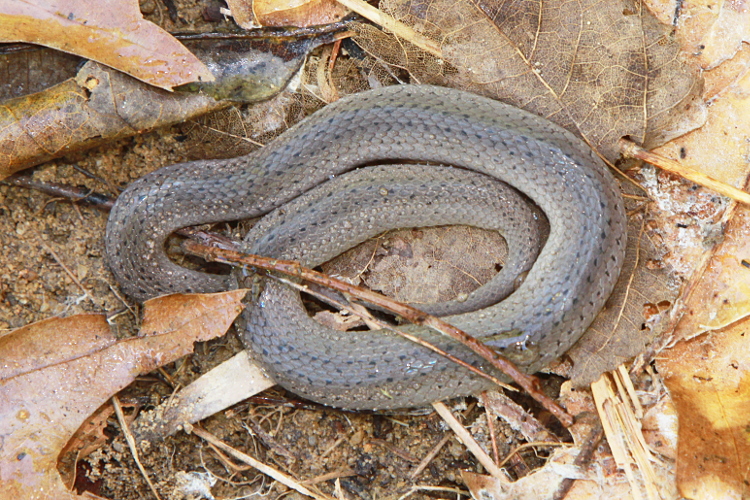
A Smooth Earth Snake (Virginia valeriae), as found under a board.
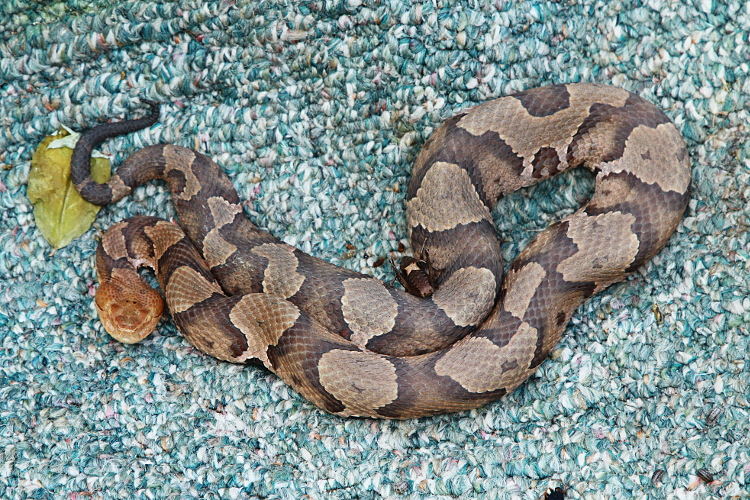
A Copperhead (Agkistrodon contortrix), almost as found between
folds of carpet.
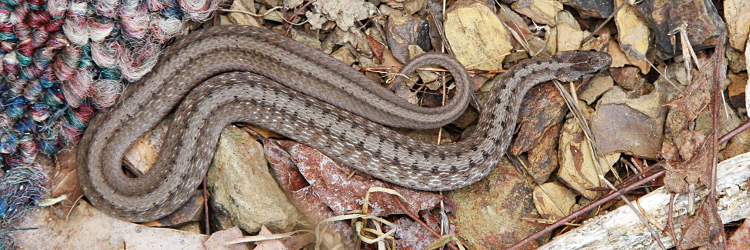
A Dekay's Snake (Storeria dekayi), as found under a pile of carpet
scraps. I believe the reason it looks so fat is a combination of the snake
being gravid and the snake flattening itself against the ground.
The flattening is a common snake behavior in the face of a threat -- it
makes them look larger and it also makes them hard to grab or bite.
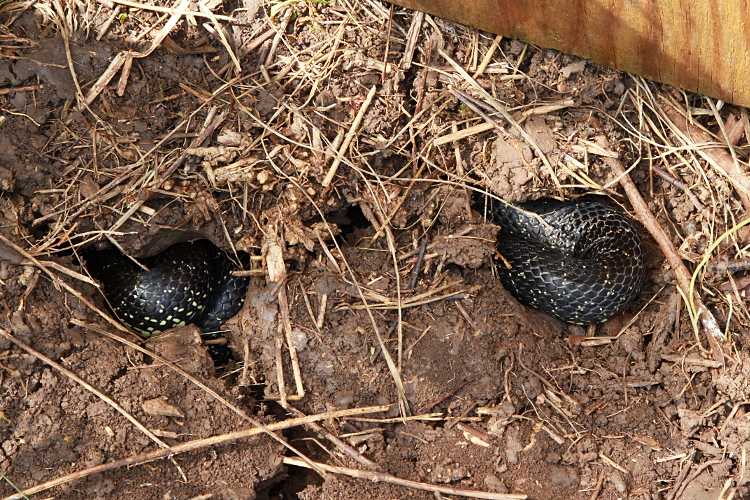
How a Black Kingsnake (Lampropeltis getula nigra) beats the heat.
Shown as found under a board.
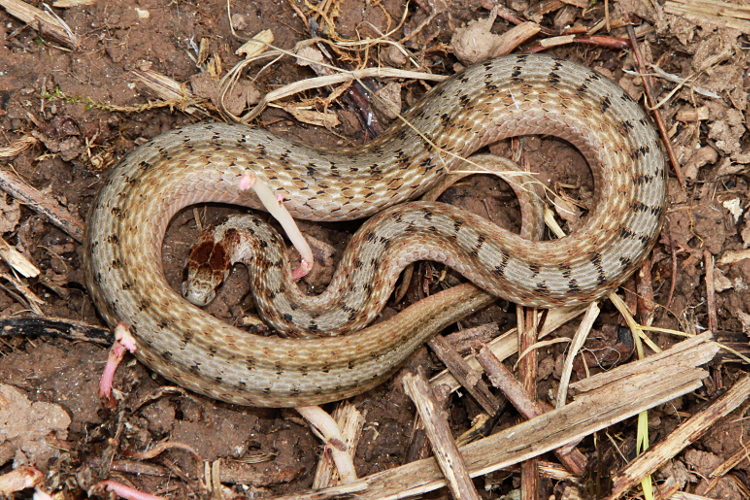
A Dekay's Snake (Storeria dekayi), as found under cover.
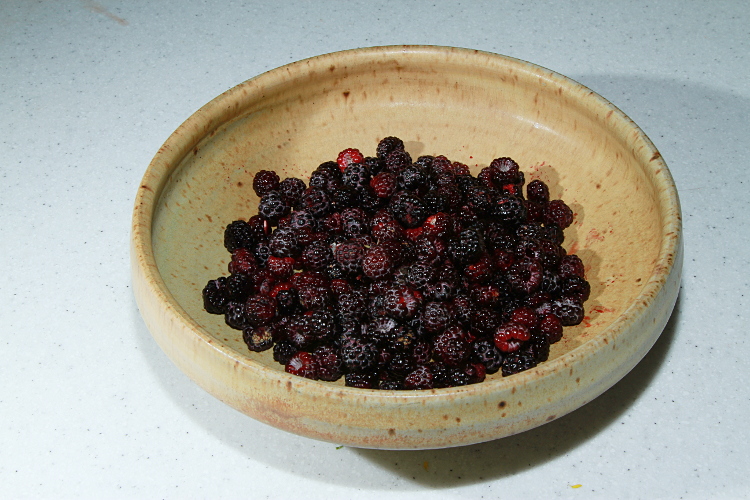
By-catch from from snake hunting in mid June. Wild black raspberries. Yummy.
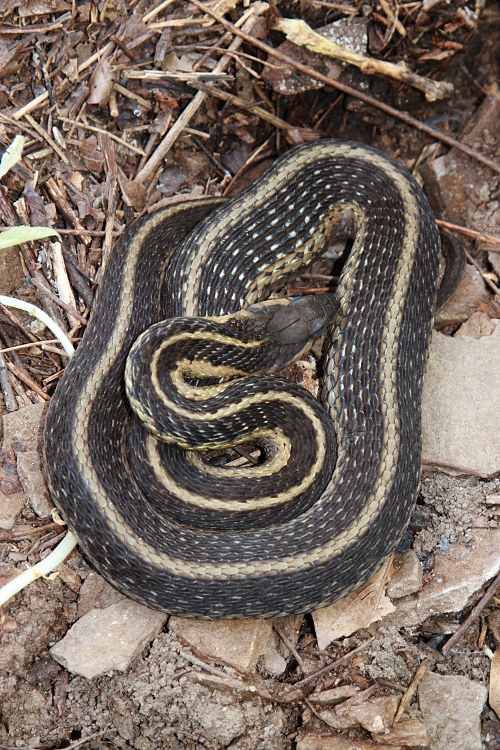
A large Common Gartersnake (Thamnophis sirtalis), almost as found
under a rock slab on a dry hillside. She is gravid and in pre-shed condition.
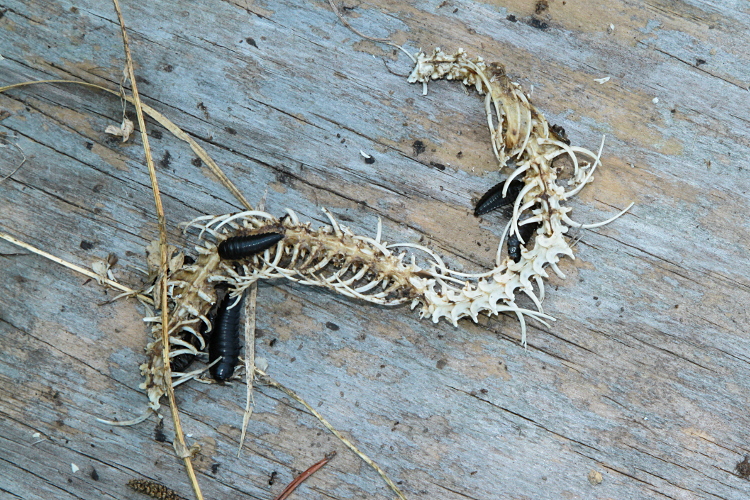
Ashes to ashes and dust to dust. Some snake bones I found on top of a board.
And some carrion beetle larvae of some sort. Kinda wonder what went down
here...
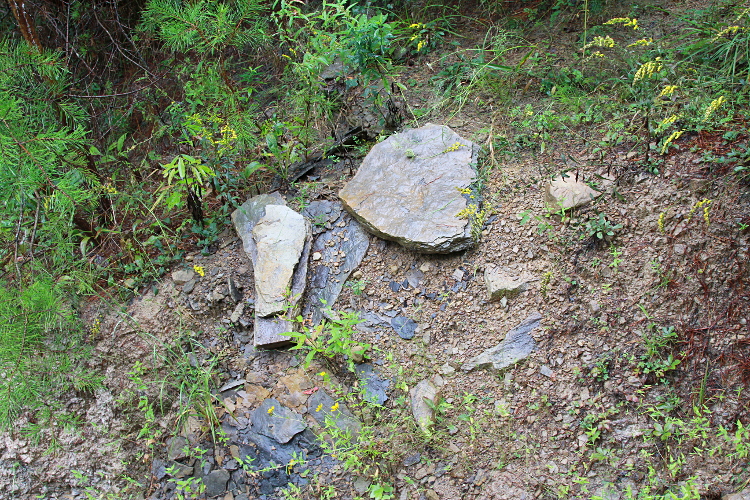
A couple of rocks on a steep hillside in a small powerline right of way,
observed on July 15.
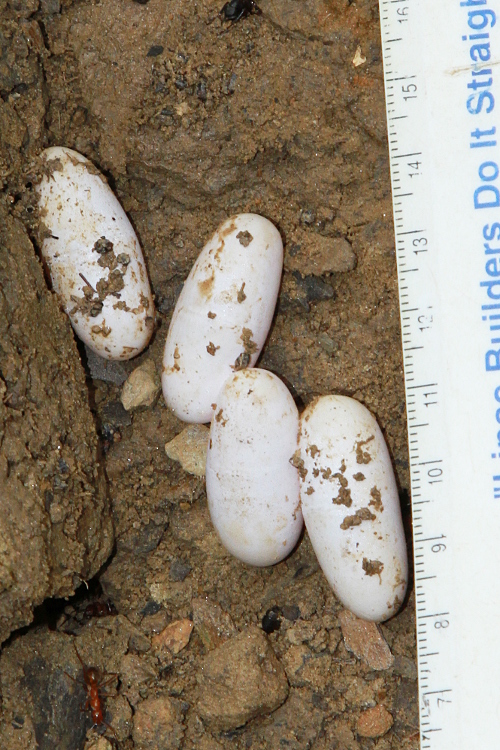
Under the rock on the left, I found these four snake eggs.
They were all about 30 mm long and 12 mm in diameter
at the widest point. Three of the four were stuck to together.
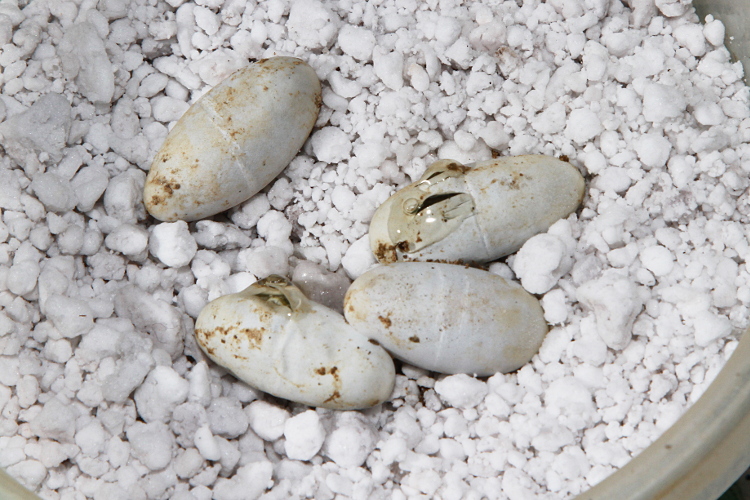
I took them home to hatch them out. On the evening of August 29, two of the
eggs were showing slits, indicating that hatching was imminent.
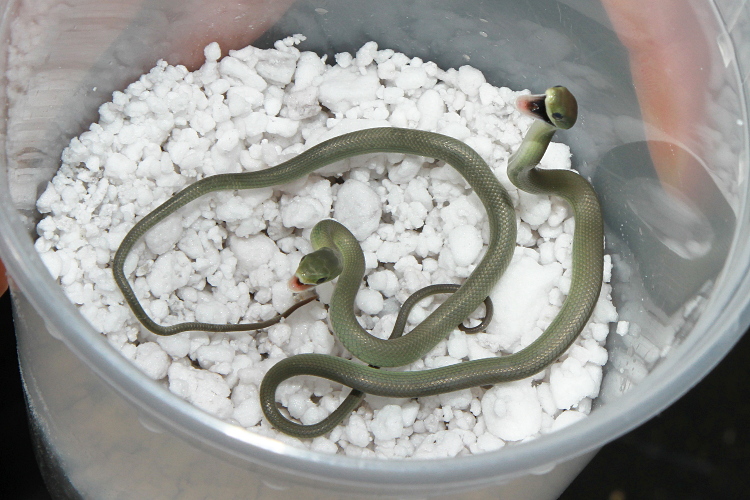
Here are the two that were hatched out on August 30.
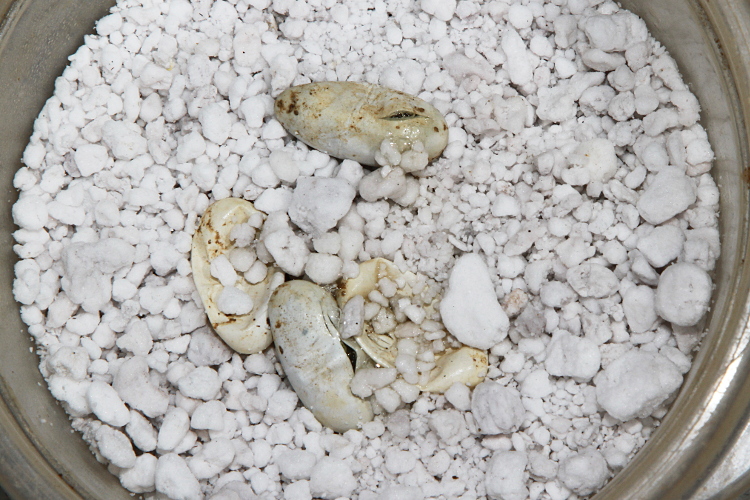
On the morning of August 31, the other two eggs were showing slits.

By the evening of August 31, the remaining two had hatched out. Here is
a photo of all four.
They were released at the location where the eggs were found, but
before doing so, measurements were taken:
| snake |
weight (grams) |
snout-vent length (mm) |
total length (mm) |
| #1 |
1.87 |
138 |
221 |
| #2 |
1.70 |
130 |
201 |
| #3 |
1.79 |
126 |
198 |
| #4 |
1.80 |
128 |
202 |
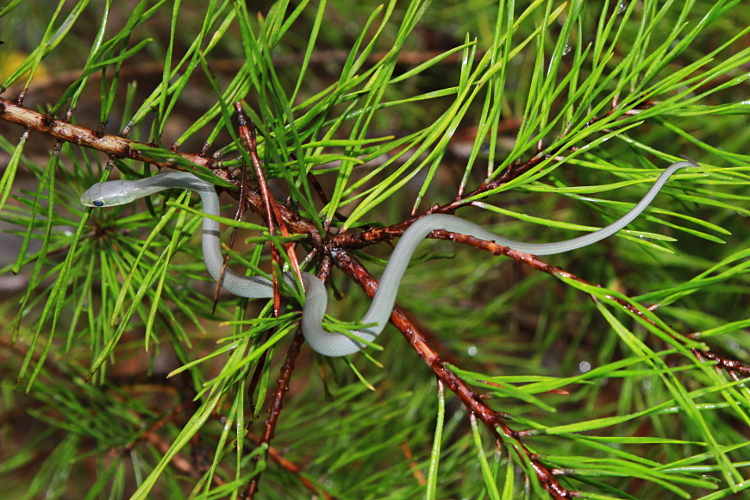
Here's one of them, posed in a pine tree when it was released.
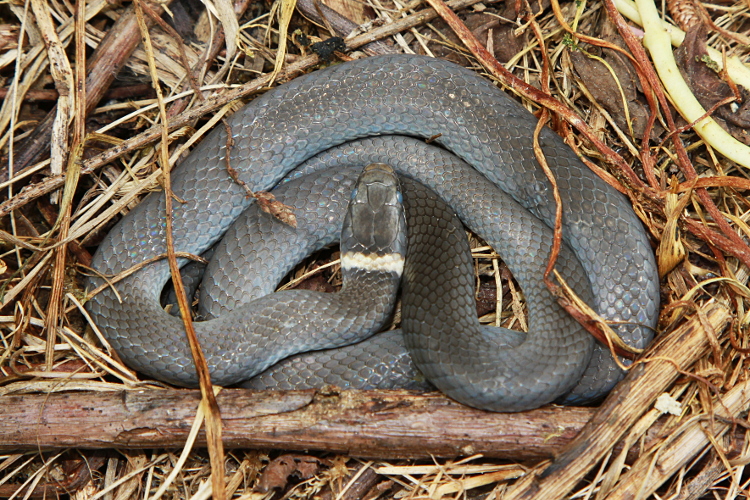
A Ringneck Snake (Diadophis punctatus), as found under cover.
It is in pre-shed condition.
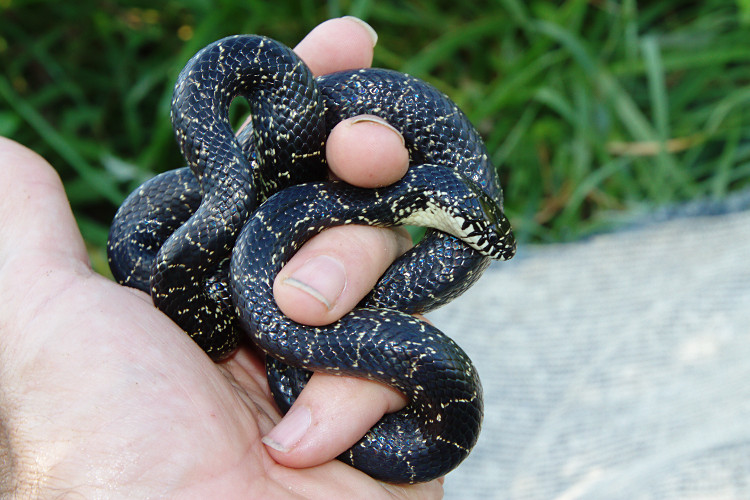
A Black Kingsnake (Lampropeltis getula nigra) found under carpet.
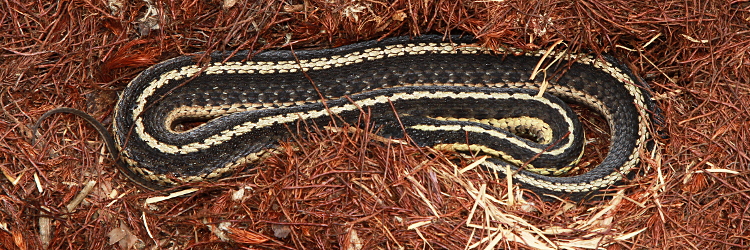
A gravid female Common Gartersnake (Thamnophis sirtalis),
as found under a board.
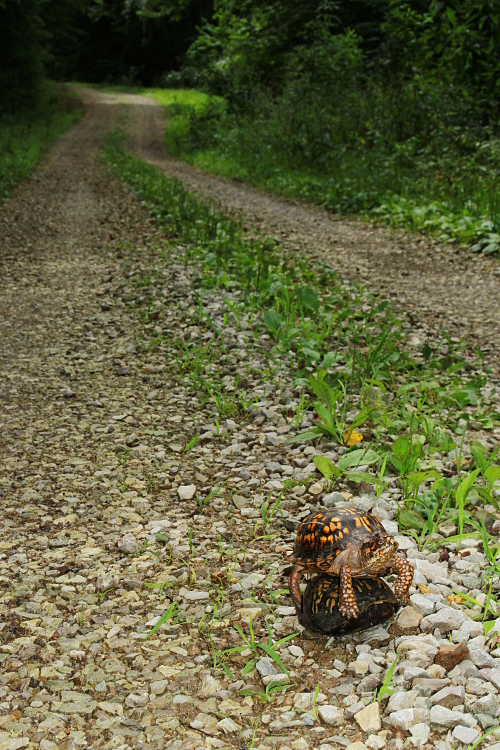
I drove up on this amusing sight in late July.
A pair of Eastern Box Turtles (Terrapene carolina).
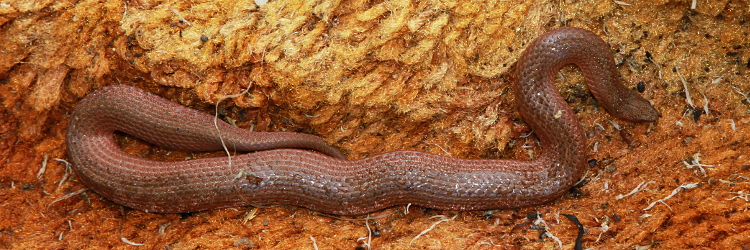
A very gravid Smooth Earth Snake (Virginia valeriae), as found
between folds of carpet.
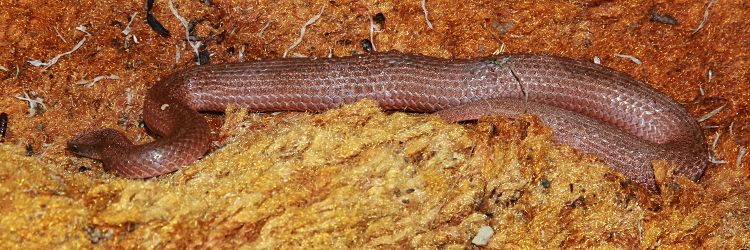
Another look at the Smooth Earth.
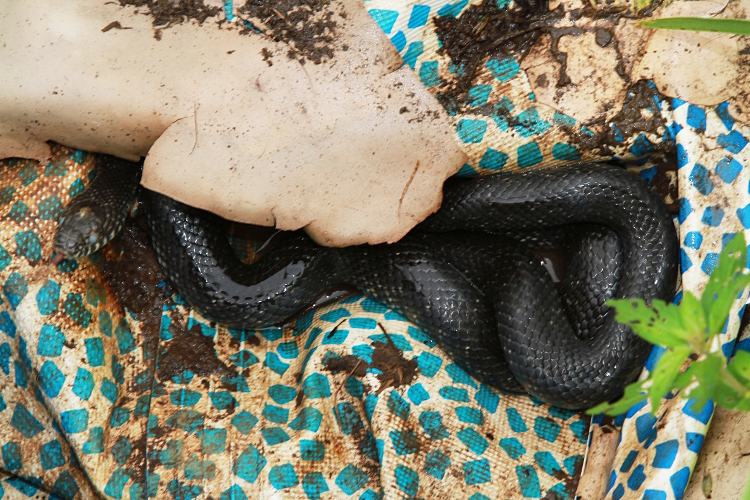
A Black Kingsnake (Lampropeltis getula nigra) found in a folded up
old wading pool. It's shown as found and is in pre-shed condition.
I find it interesting that the snake chose to hang out in a spot with about
0.5'' of water in it -- there were plenty of spots in the folds where it was
dry. I guess it makes sense given that captive snakes will do this.

I noticed for the first time this historical marker in the town of Waterloo.
I'd driven past it many times before -- it is kind of hidden in someone's yard.
In any case, the story of the Waterloo Wonders is even better than the
Hoosiers. If you've got a couple minutes, there is a 1995 Sports Illustrated
article about them:
The Wonder Years, From 1933 to '35, a high school team from tiny Waterloo laid waste to Ohio, by Thomas Kunkel.
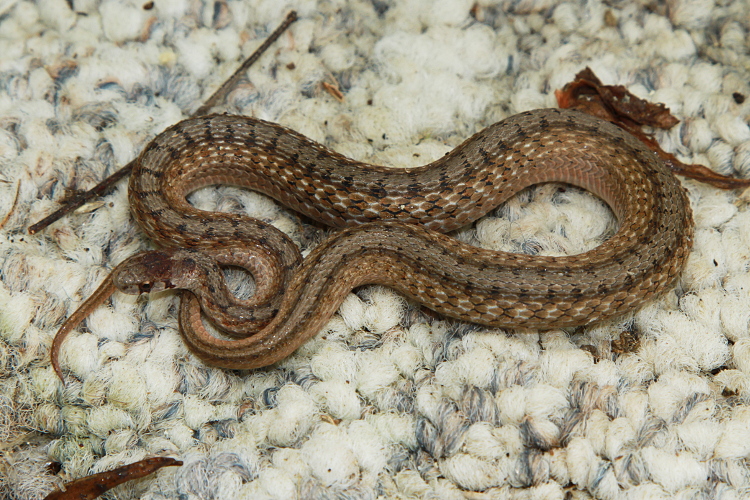
A gravid Dekay's Snake (Storeria dekayi), as found between folds
of carpet on July 23.
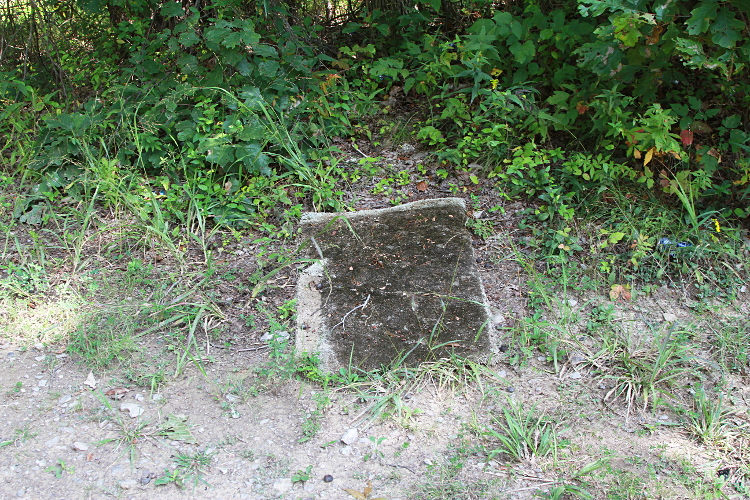
I've been checking this carpet for a few years and all I have ever
seen is one Worm Snake.
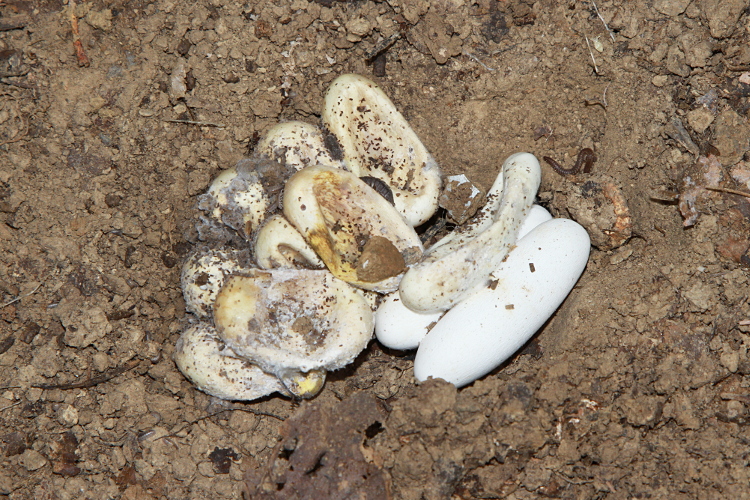
However, on August 6, I found these snake eggs. Most of them were clearly
not good but a couple looked OK so I took them home.
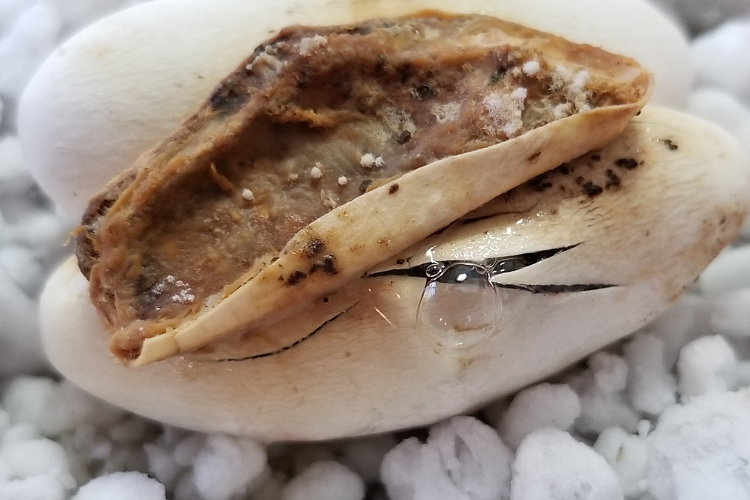
On September 21, one of them hatched. I was out of town when this happened.
Rox took the photo and texted it to me.
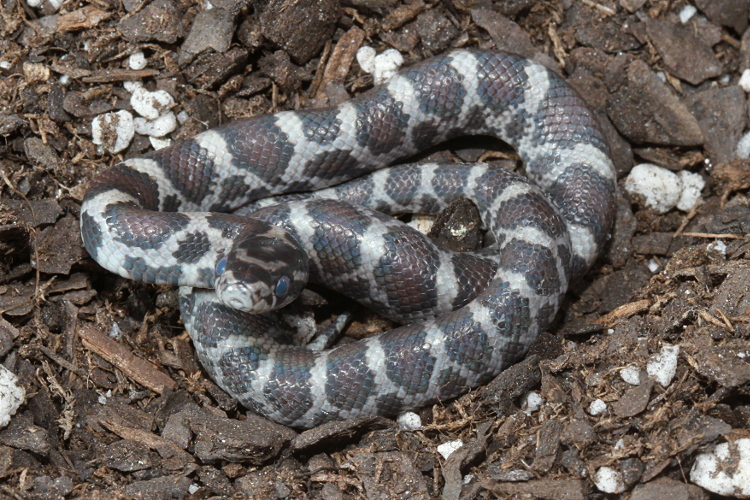
Here's the hatchling Milksnake (Lampropeltis triangulum), before
I released it at its point of origin. The other egg did not hatch
(there was a partially developed snake inside the egg shell).
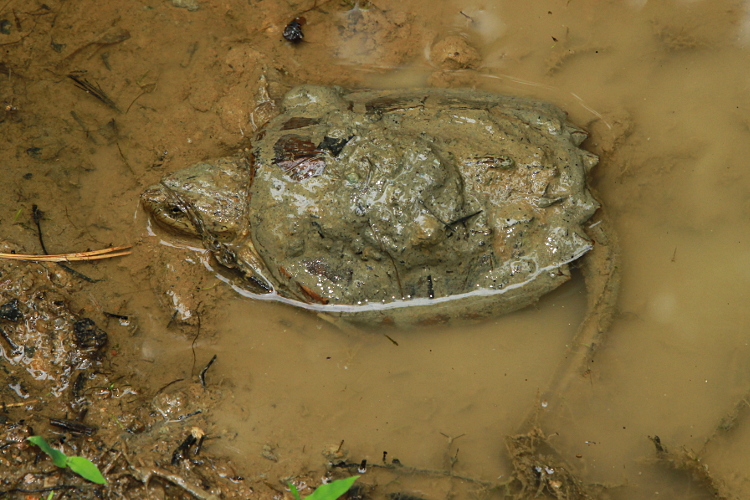
A sub-adult snapping turtle that I found in early August. It was in
some water in a tire rut on a mostly abandoned road located deep in the
forest on a high ridgetop. Far from any body of water or other sort of
“appropriate” habitat for an aquatic turtle.
This species, along with the bull and green frog, has a remarkable ability
to colonize new ponds etc...
The strong pioneer spirit, such as that exhibited by this turtle,
is the reason why.
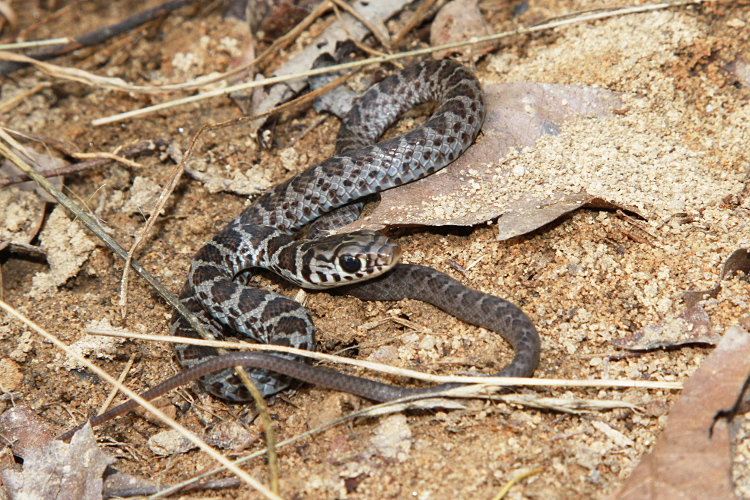
A hatchling Black Racer (Coluber constrictor), almost as found
under a board on August 15.
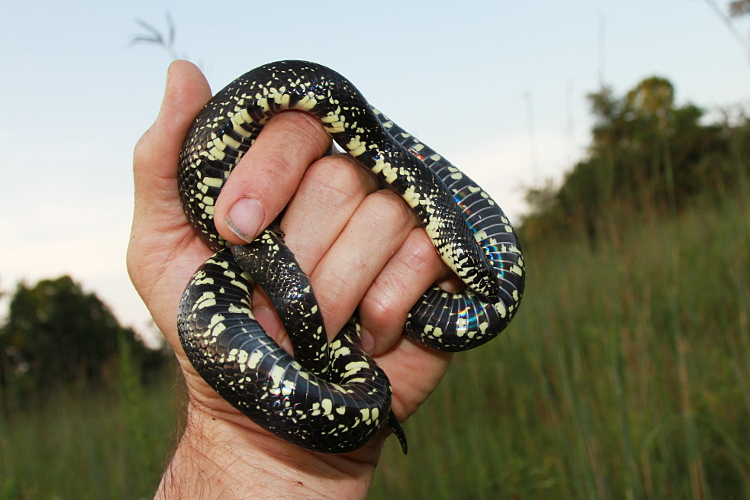
A Black Kingsnake (Lampropeltis getula nigra) that was found
under cover at sunset.
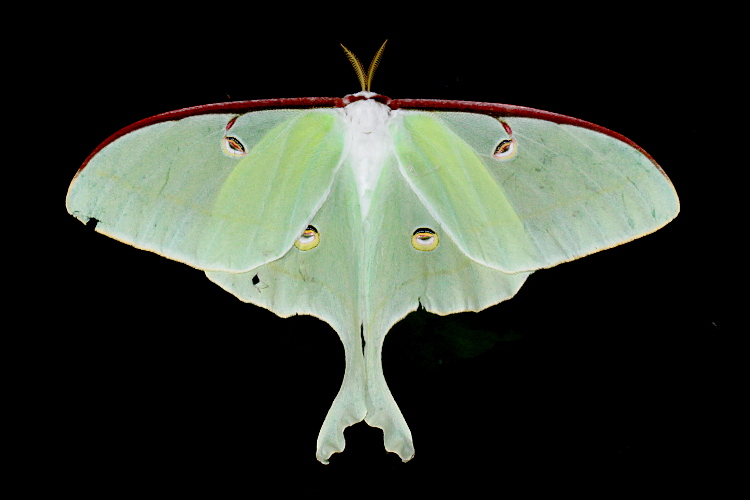
A Luna Moth hanging out on our window one evening.
They are really impressive. It's got a wingspan of about 5''.
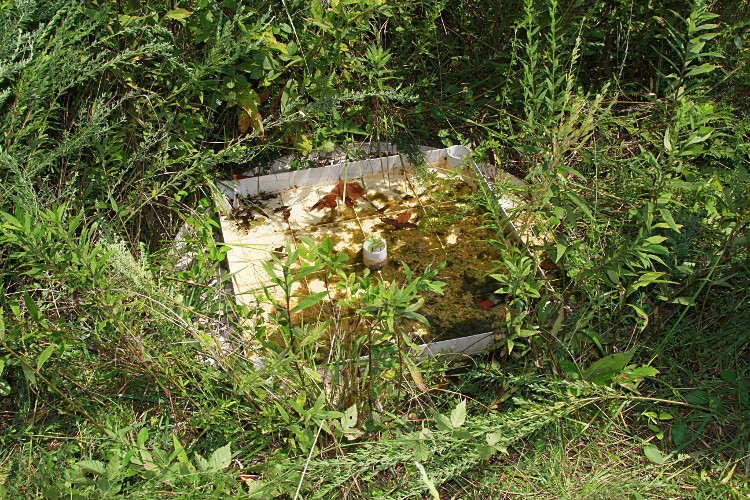
This old upside-down patio table traps about 2'' of rainwater.
Surprisingly, it is viable breeding habitat for Grey Treefrogs.
I'm kind of curious what they eat. Most all of the detritus in the water is
tadpole poop.
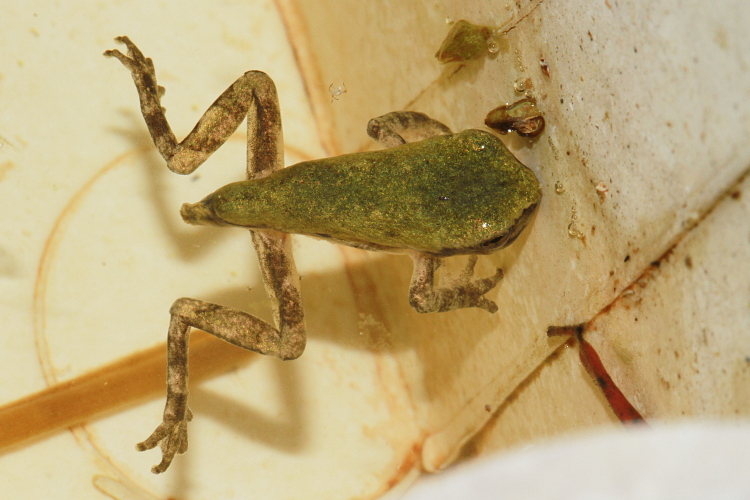
A metamorph observed in water in shallow water.
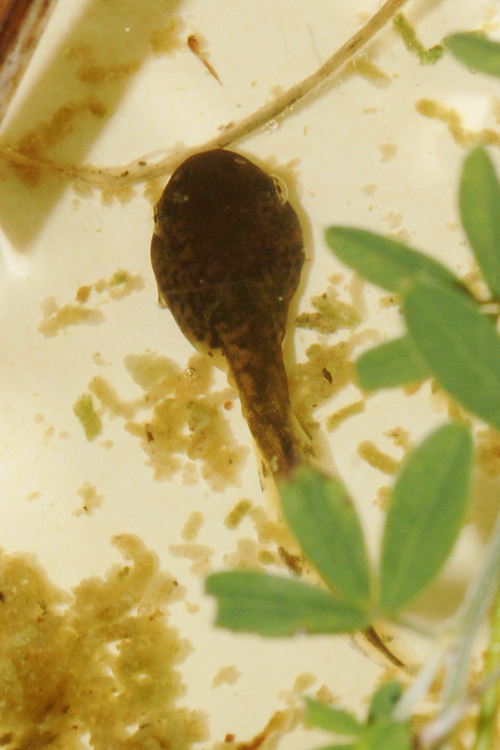
A Grey Treefrog tadpole.
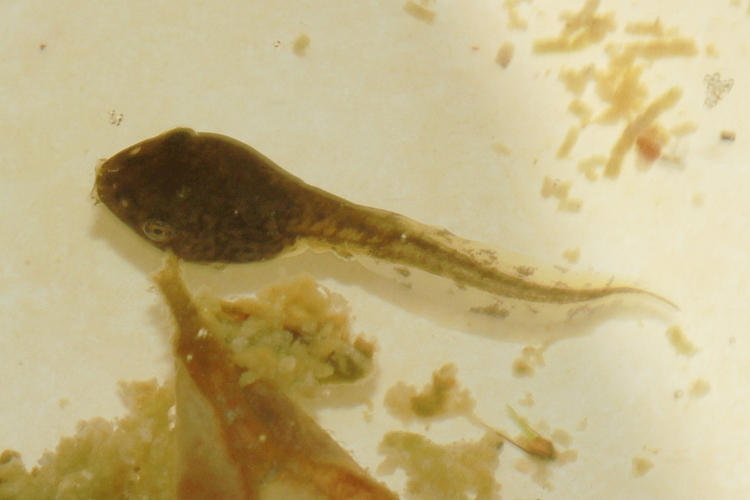
Another tadpole. Nature finds a way.
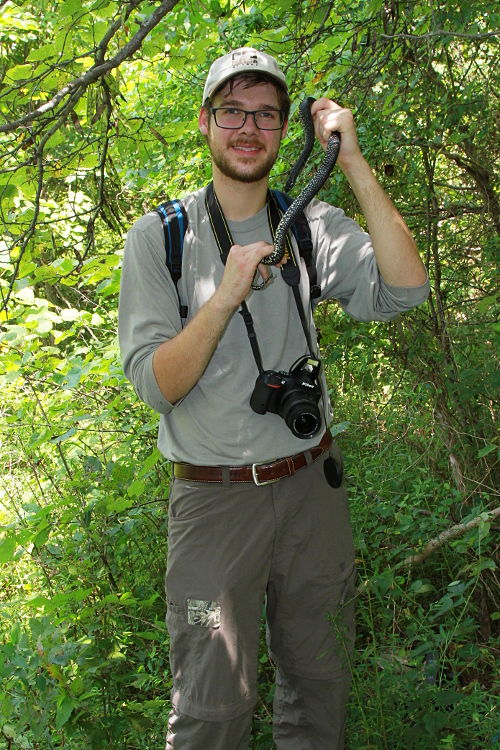
My friend Ryan Wagner and a Black Kingsnake
(Lampropeltis getula nigra).

One of two Black Widow spiders found under some rocks.
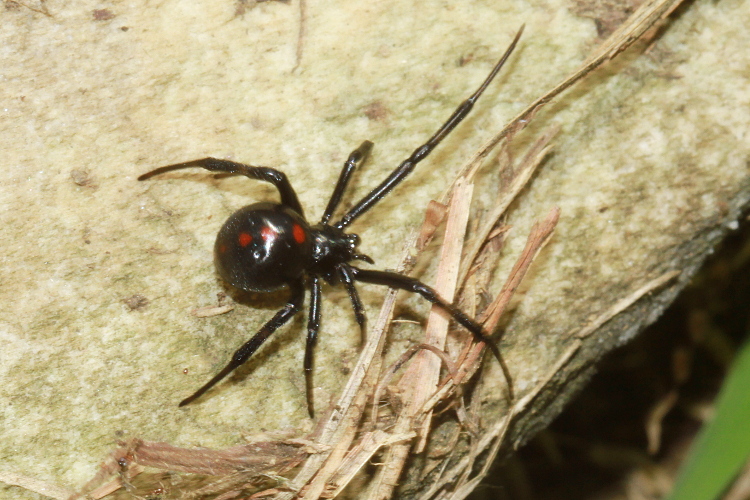
The other Black Widow. I do not see these often but they
“are around” in southeast Ohio.
I also saw one in a woodpile at our house this year.
Where I grew up in the California desert, you could find dozens of them
if you walked around the outside of buildings with a flashlight at night.
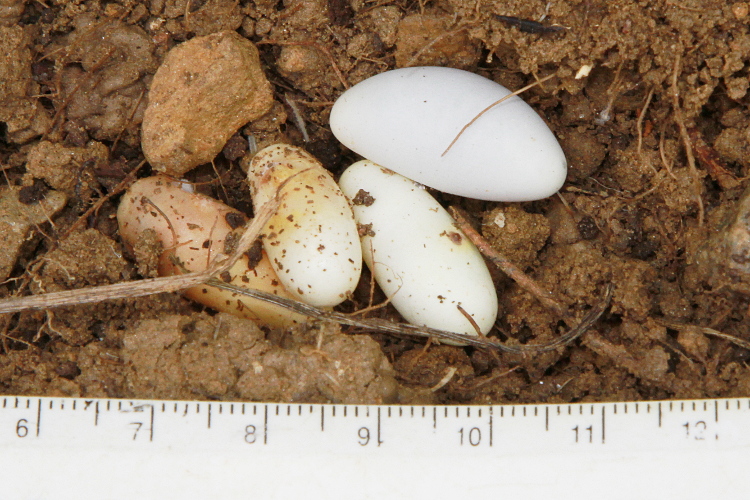
Some snake eggs found under a carpet on August 19.
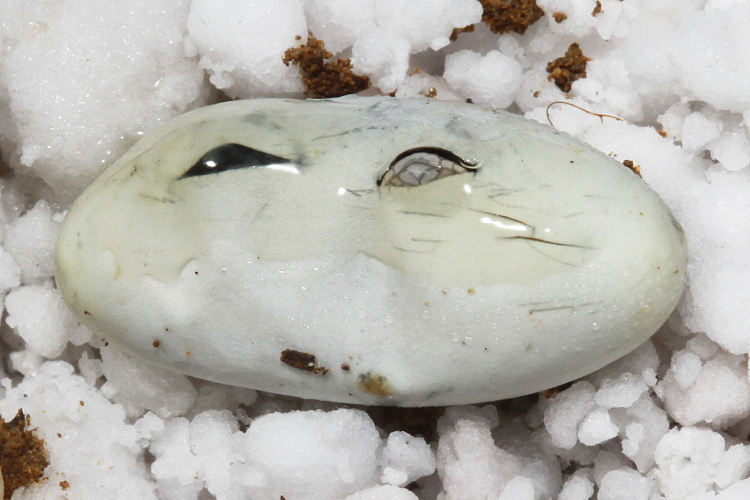
One of the eggs started to hatch of September 3.
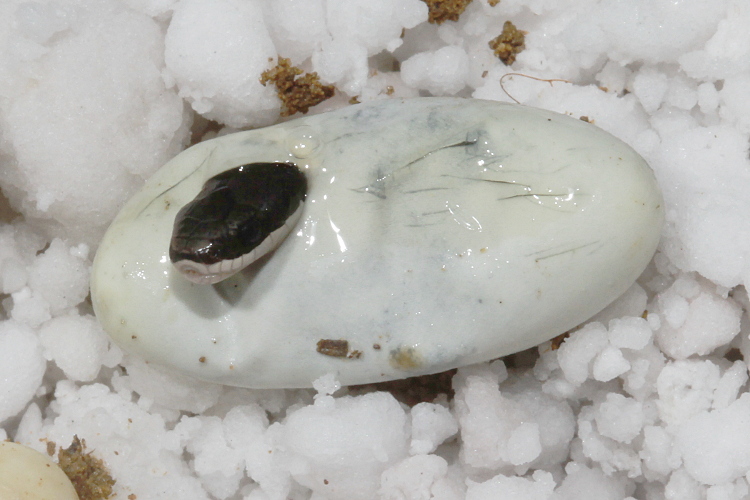
It had still not come out on September 4. Curiously, it switched to a
different slit in the egg.
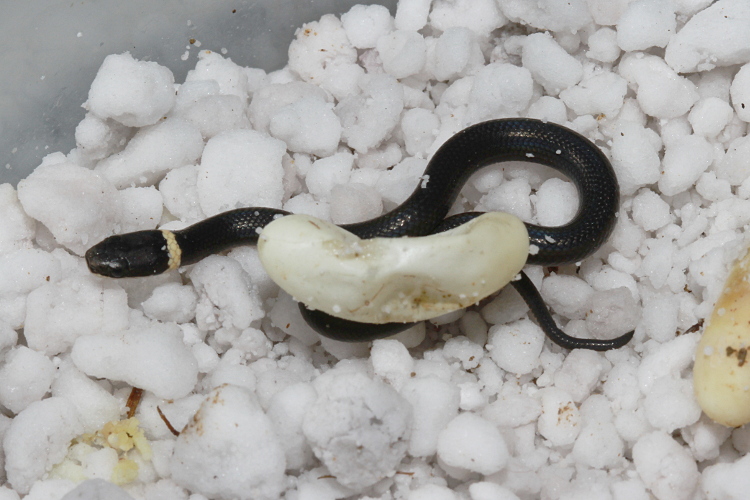
One September 5 it came out all of the way. It weighed 0.78 grams and
measured 95 mm snout-vent length and 120 mm total length.
It was released at the point of origin.
At the last minute Rox and I decided to take a road trip to check out the
total eclipse. We ended up in a cemetery in Cookevile, TN. Fortunately,
the weather cooperated and there were no clouds and we were able to bask
in about two and a half minutes of totality. There is no substitute for a
100.0% total eclipse experience! Do it if you ever get the chance.

A little bit before totality. This is taken with my Canon 7D looking through
eclipse glasses. I was totally unprepared photographically and just brought
my camera as an afterthought.
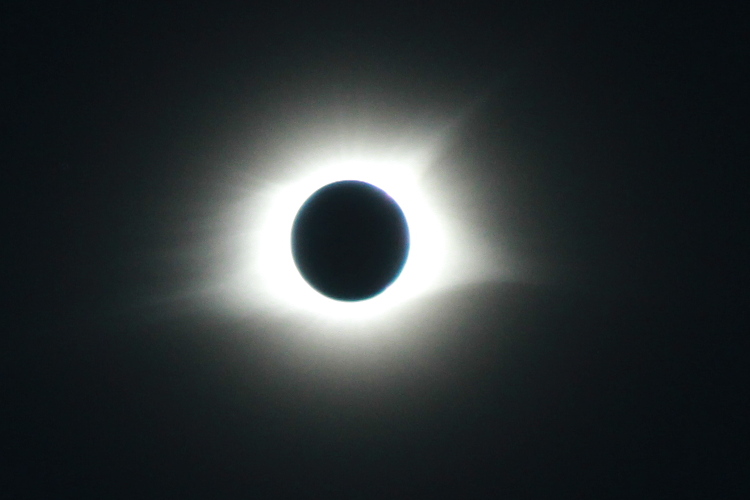
Totality.
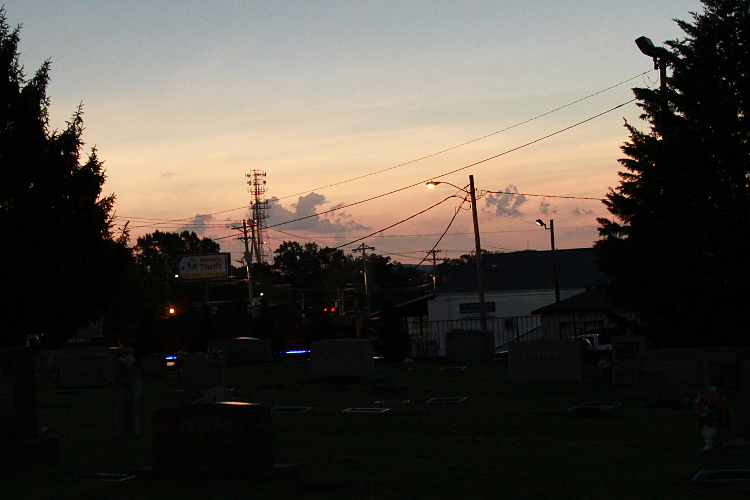
Cookeville at total eclipse. It got very dark. The street lights came on.
And it looked like a sunset in the distance.

Total eclipse selfie.
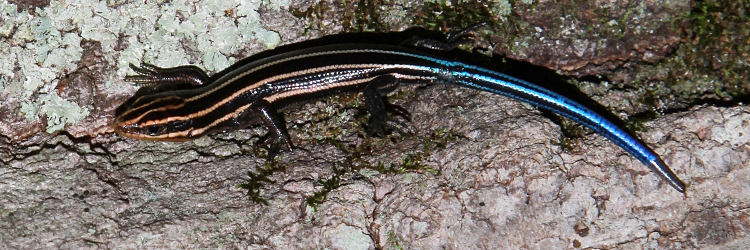
A tiny hatchling Fivelined Skink (Eumeces fasciatus) that I saw
in late August. It had already accumulated some battle scars, including
a regenerated tail tip.
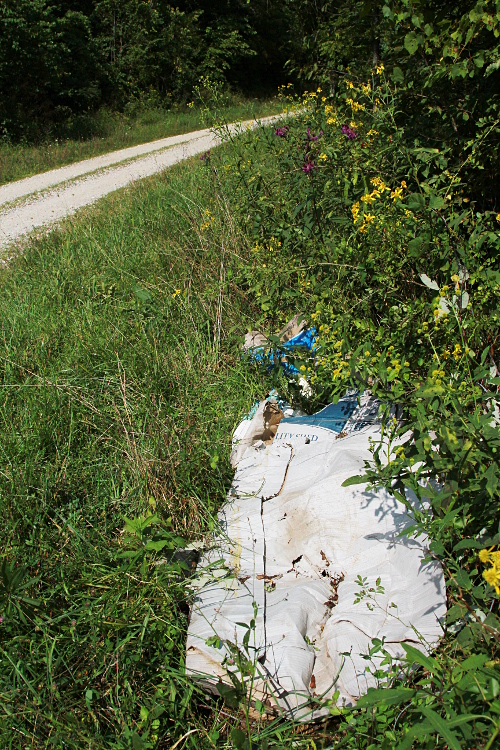
I was driving down a country road and saw this rubbish on the side of the
road. I had to check it.
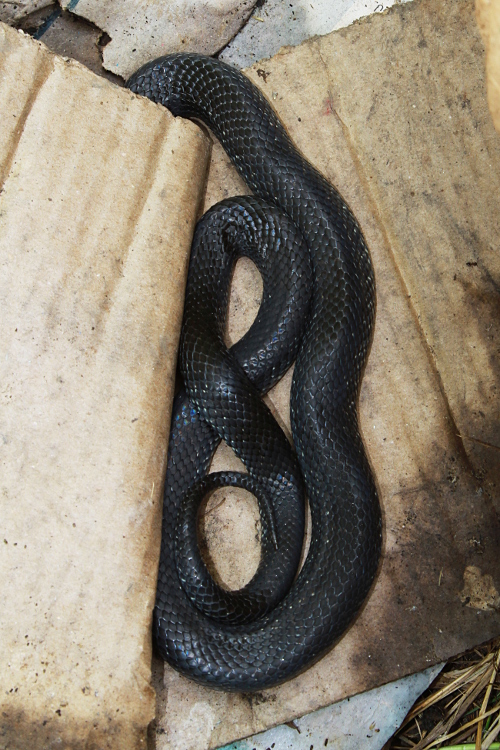
After unfolding the first layer.
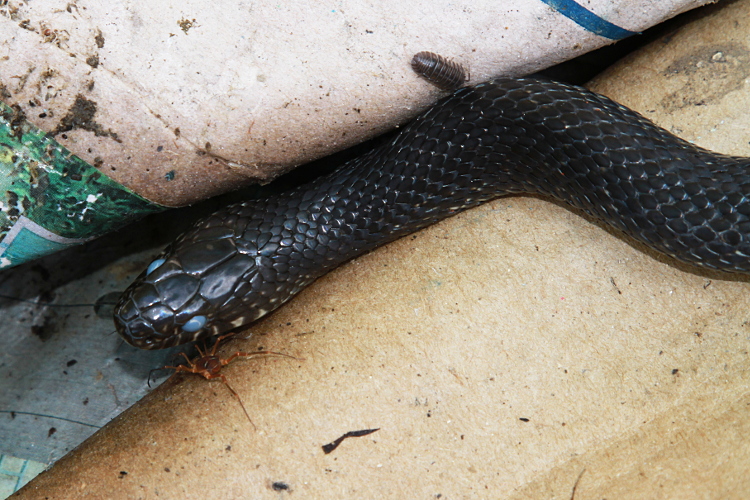
And then the next layer. A Black Kingsnake (Lampropeltis getula nigra),
deep in a shed cycle.
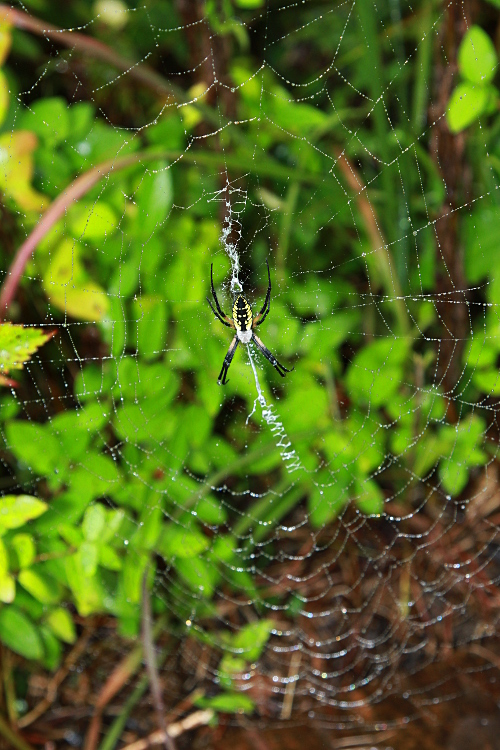
A Zipper Spider aka Black and Yellow Garden
Spider aka Argiope aurantia.
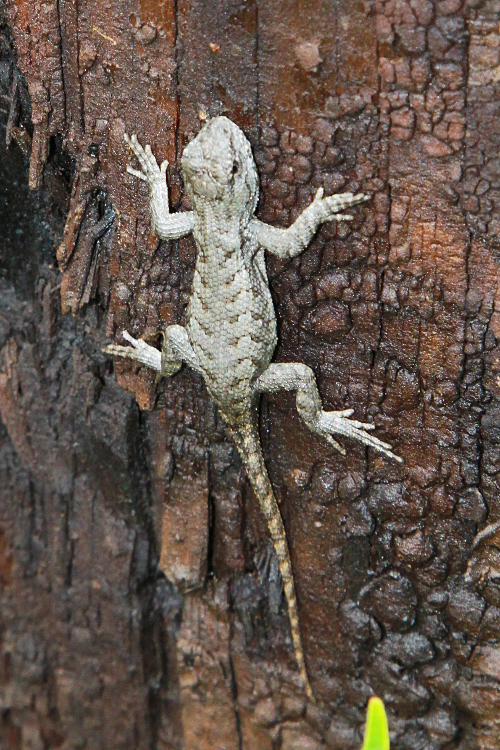
A young Eastern Fence Lizard (Sceloporus undulatus), as spotted
on a telephone pole.
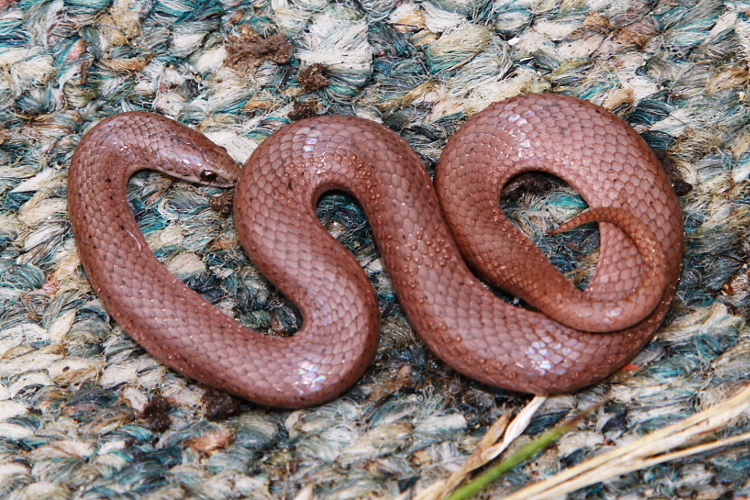
A Smooth Earth Snake (Virginia valeriae), as found between
folds of carpet.
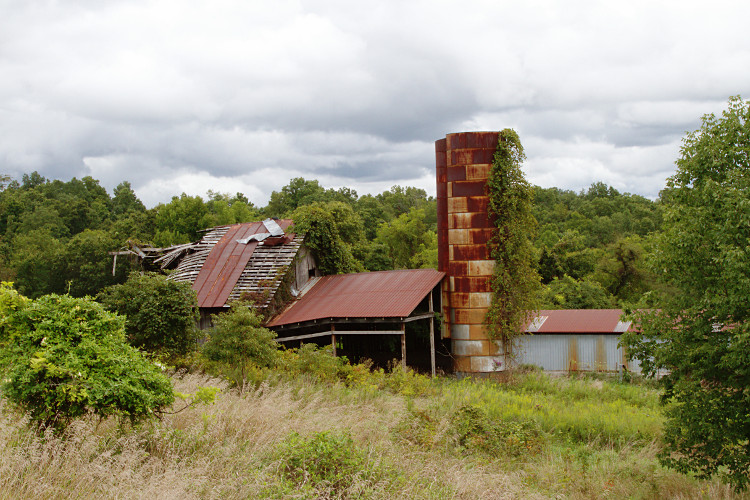
An old barn in southeast Ohio's Amish country, being retaken by mother nature.
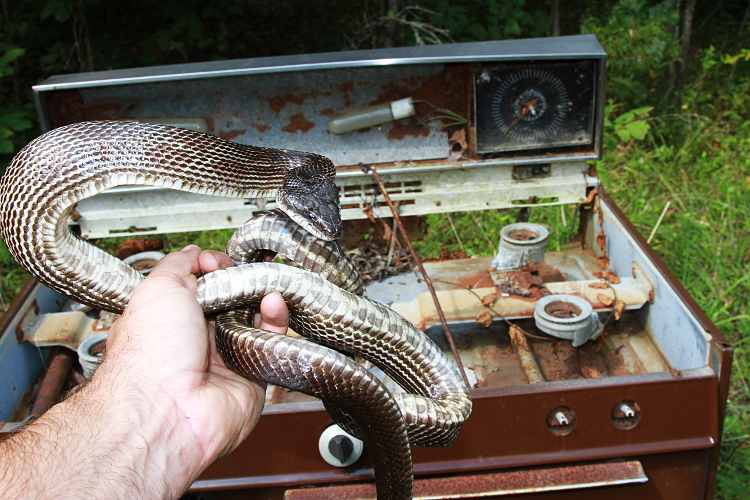
A Black Ratsnake (Elaphe obsoleta), found inside an old discarded stove.
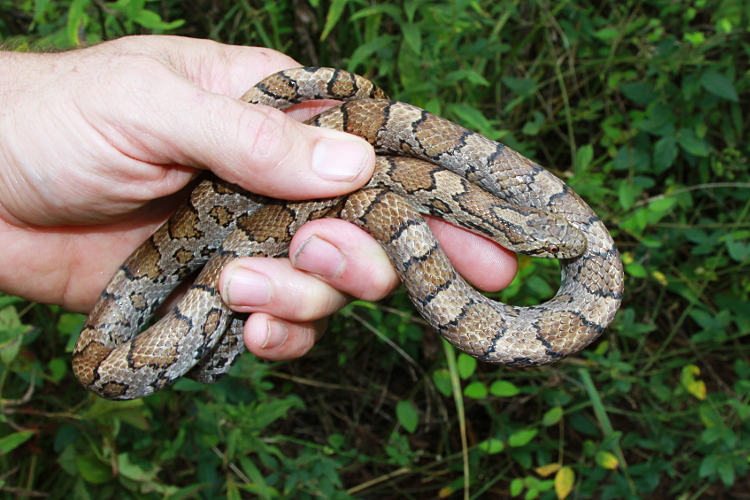
An attractive Milksnake (Lampropeltis triangulum) --
“buckskin” phase.
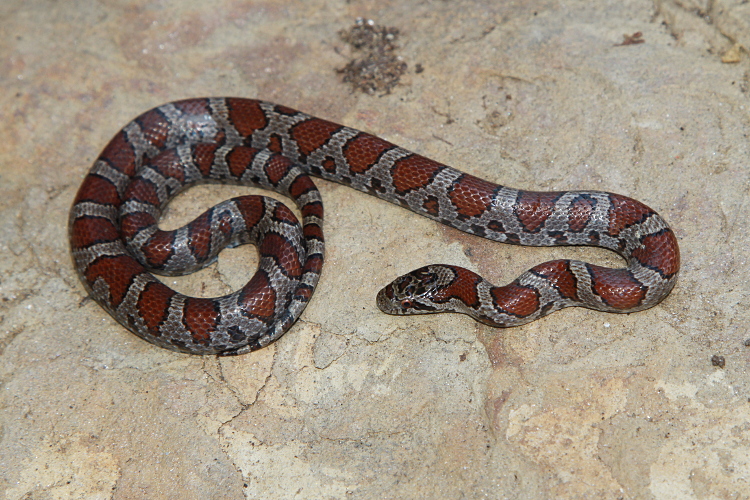
Another attractive Milksnake (Lampropeltis triangulum) --
“scarlet and gray” phase.
There was a nice breeze in rural southeast Ohio on September 9th and many
flags were seen flying in fine form.
Statements of loyalty and identity, perhaps. Here's some of them.

The Confederate flag is not unusual to see around here.
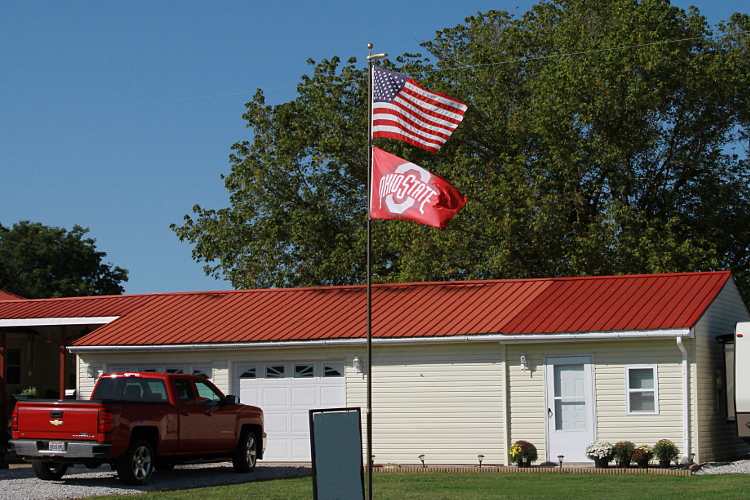
The Ohio State flag is also very popular. This did not turn out to be a good
day for the Buckeyes, as they were beaten by the Oklahoma Sooners --
which made my son sad but my dad happy...
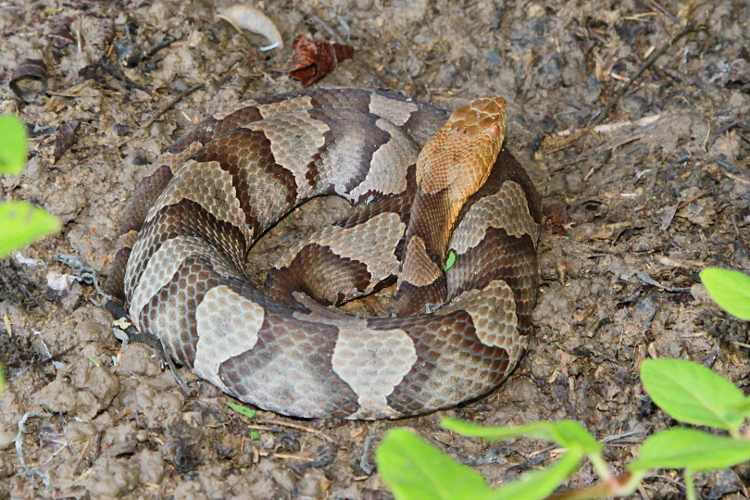
A small Copperhead (Agkistrodon contortrix), as found under a board.
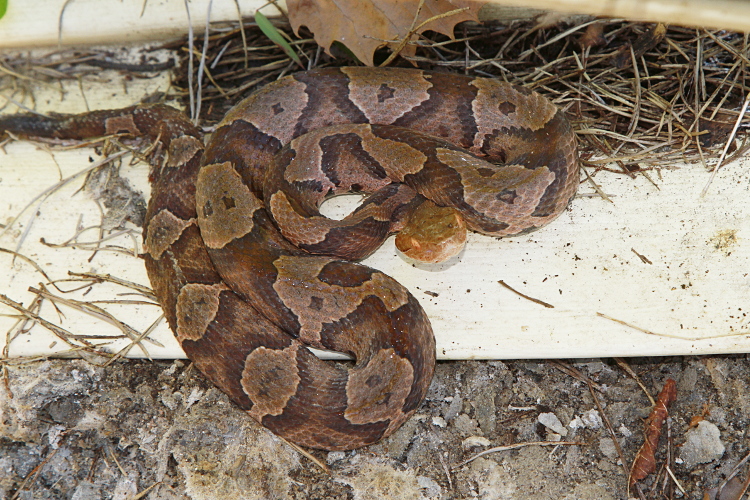
A grumpy Copperhead (Agkistrodon contortrix) found in some plastic
siding.
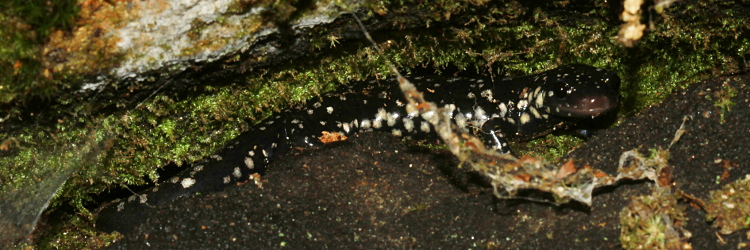
A Northern Slimy Salamander (Plethodon glutinosus), as spotted in
a crevice.
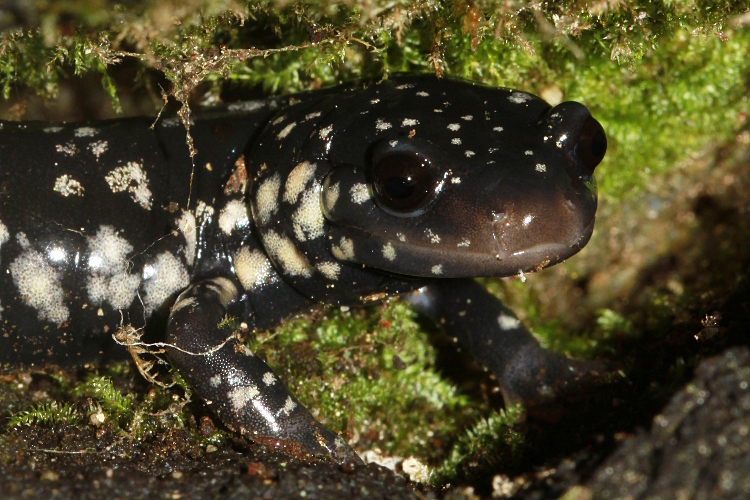
A closer look. But this is not what we were looking for.
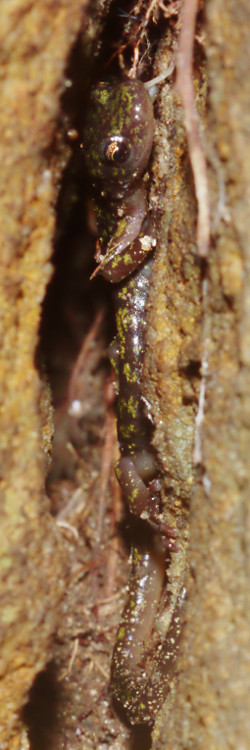
This is the target. A Green Salamander (Aneides aeneus) as observed
in a vertical rock crevice.
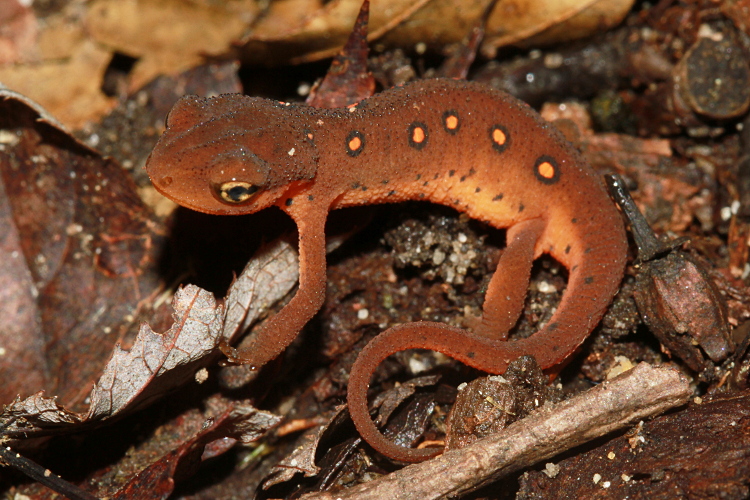
An Eastern Newt (Notophthalmus viridescens) eft found crawling on the
forest floor.
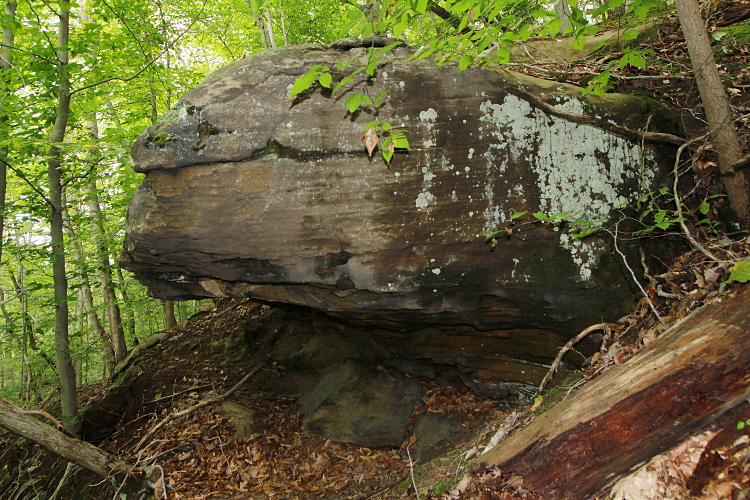
Green Salamander (Aneides aeneus) habitat.
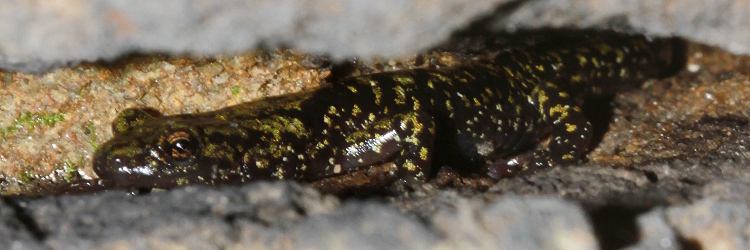
Another Green Salamander.
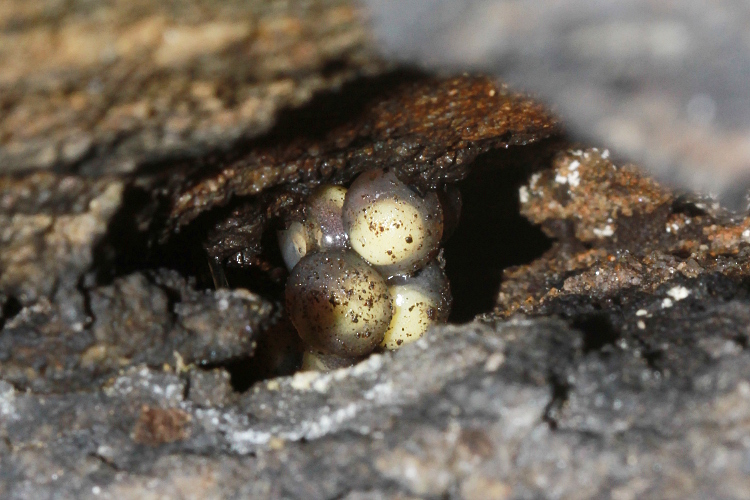
What I believe are Green Salamander eggs spotted in a crevice.
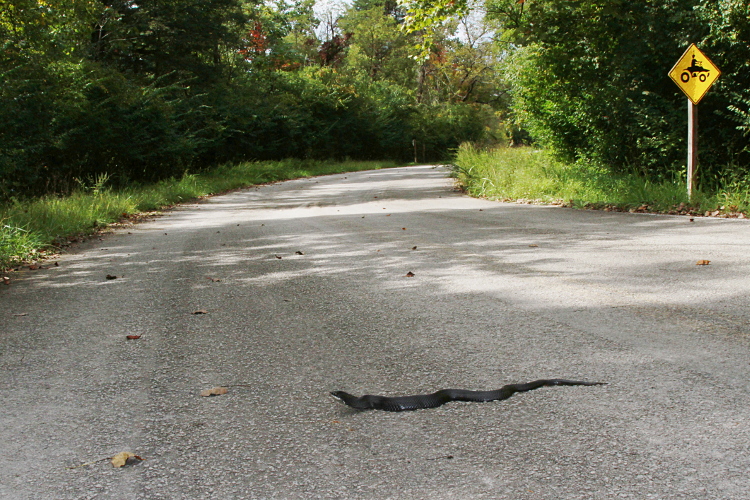
A big gorgeous black Eastern Hog-nosed Snake (Heterodon platirhinos)
found crossing a road. A couple of county sheriffs drove up while we were
admiring the serpent.
One them remarked “That's no ordinary blacksnake.” Enough said.
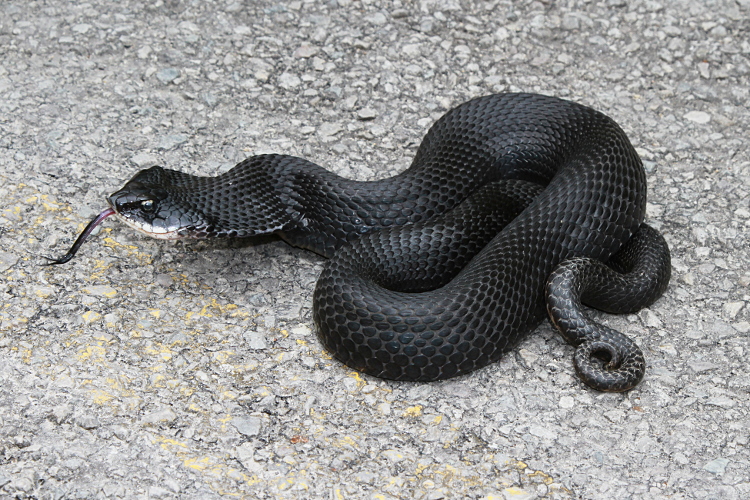
Another look at the Hog-nosed Snake.
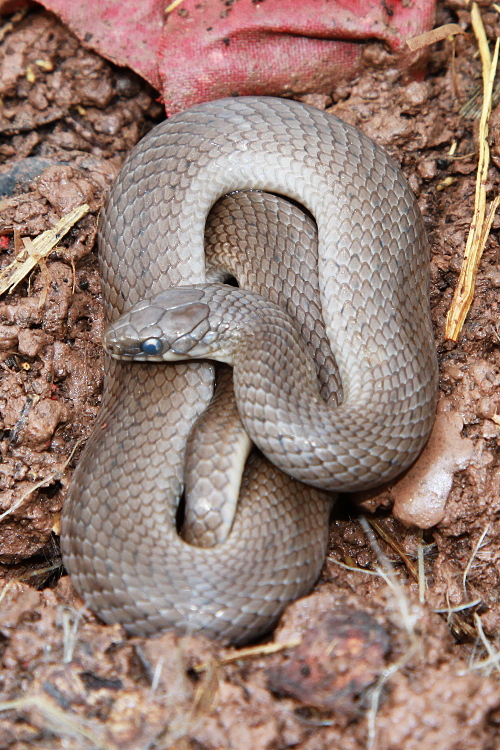
A Smooth Earth Snake (Virginia valeriae), as found under cover.
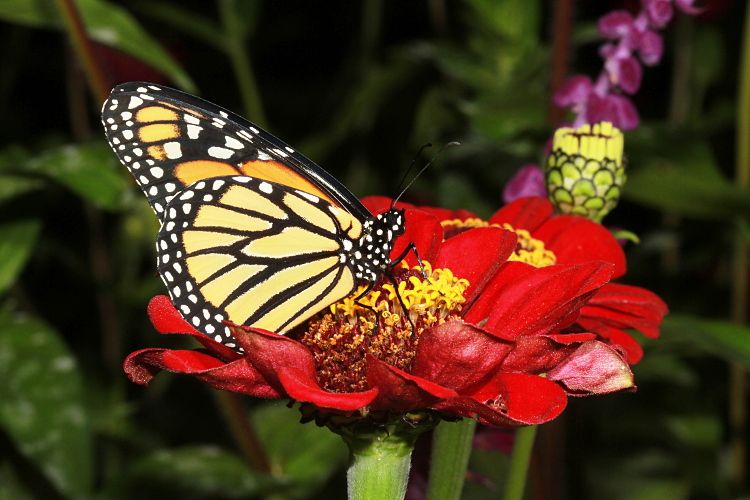
Rox collected a few mature monarch caterpillars and let them finish that
stage of life in captivity. We let this one go one morning after it had
emerged from its chrysalis overnight.
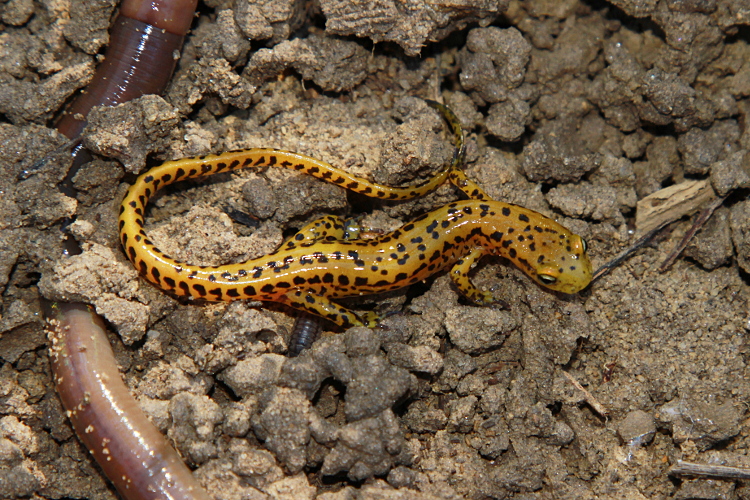
A Long-tailed Salamander (Eurycea longicauda), as found under
a board on a dry ridgetop. Makes one wonder where it came from...
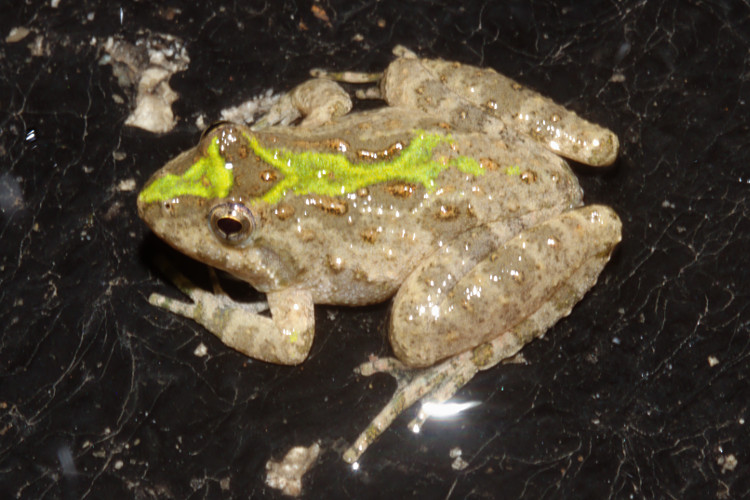
A Blanchard's cricket frog (Acris crepitans blanchardi) found
on a road on a rainy night.
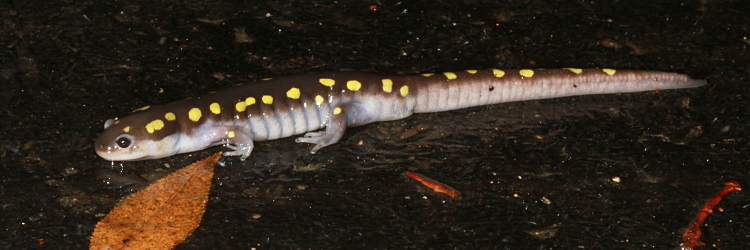
A Spotted Salamander (Ambystoma maculatum) was also seen out in
the rain.
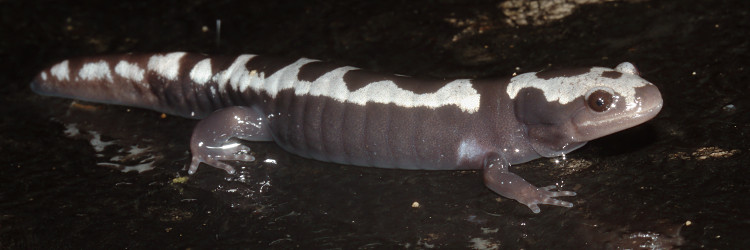
Several Marbled Salamanders (Ambystoma opacum) were also out and about.
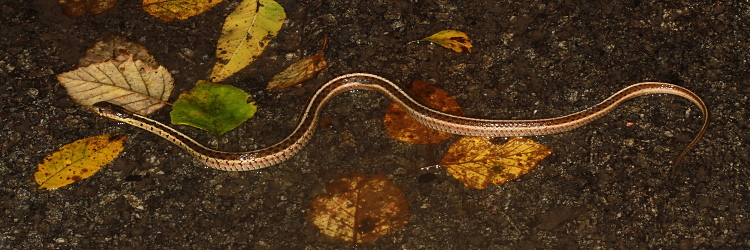
As were the Common Gartersnakes (Thamnophis sirtalis).
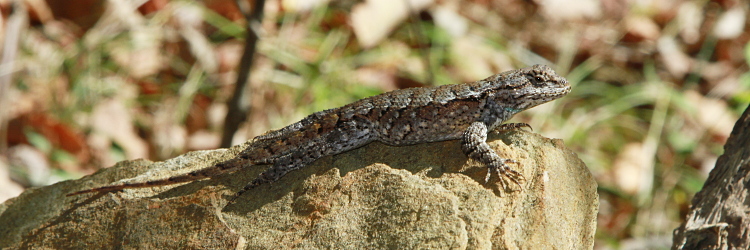
An Eastern Fence Lizard (Sceloporus undulatus) observed in mid
October, catching some of the last useful rays of the season.
I just love the lazy lizard posture with hind legs extended straight back.
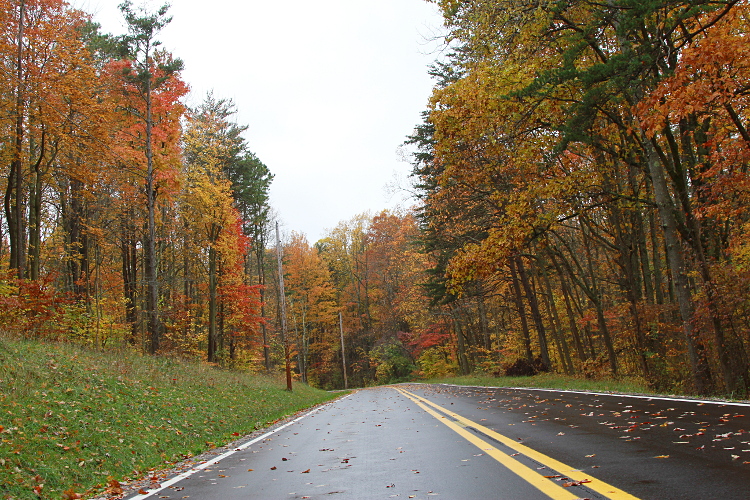
We had a warm fall and there were still nice colors in the first week
of November.
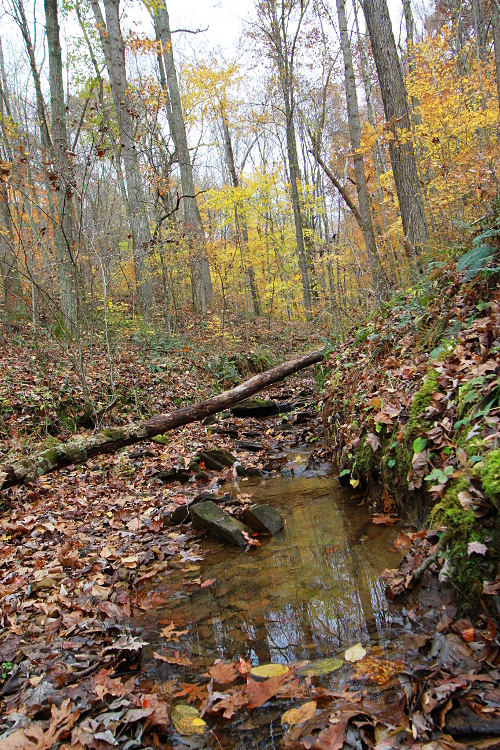
A nice little creek.
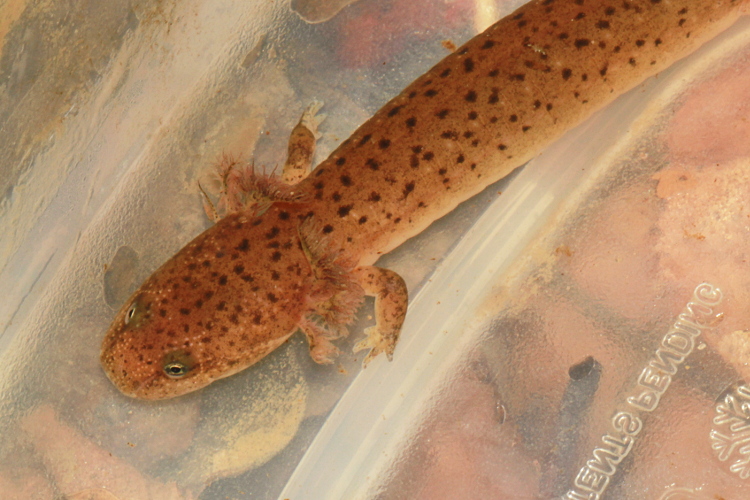
One of several Red Salamander (Pseudotriton ruber) larvae
found in the creek.
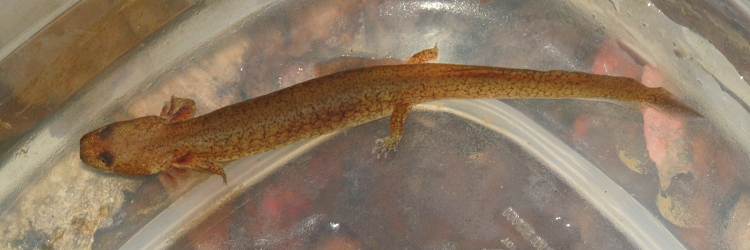
A Northern Spring Salamander (Gyrinophilus porphyriticus porphyriticus)
larva.
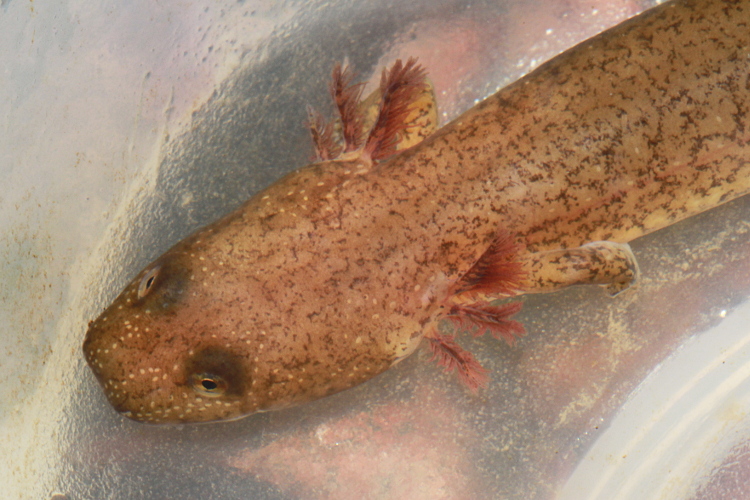
A closer look.
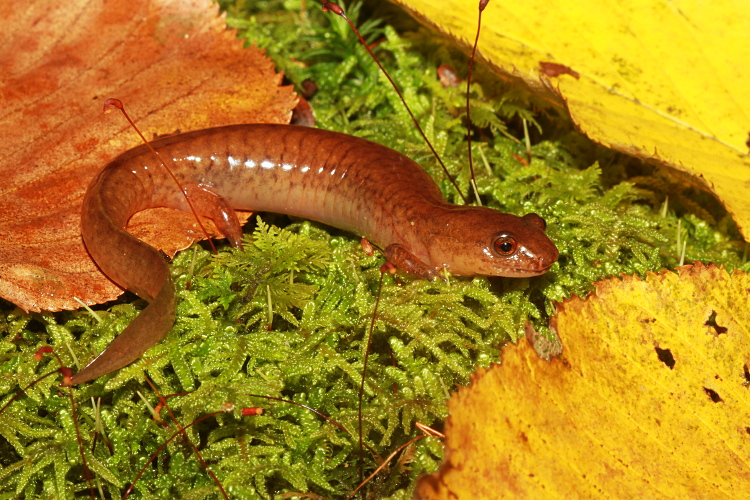
A Northern Spring Salamander (Gyrinophilus porphyriticus porphyriticus).
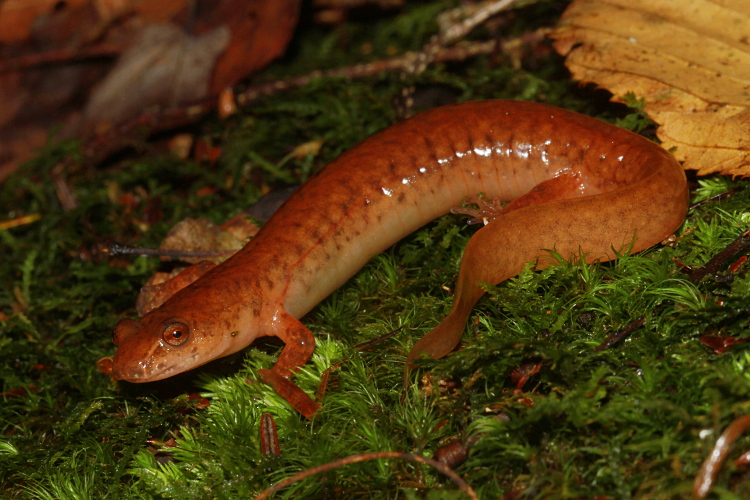
Another Spring Salamander.
That's it for 2017. The end of 2017 turned bitterly cold. Hopefully that
does not continue for too long into 2018.





























































































































































































